
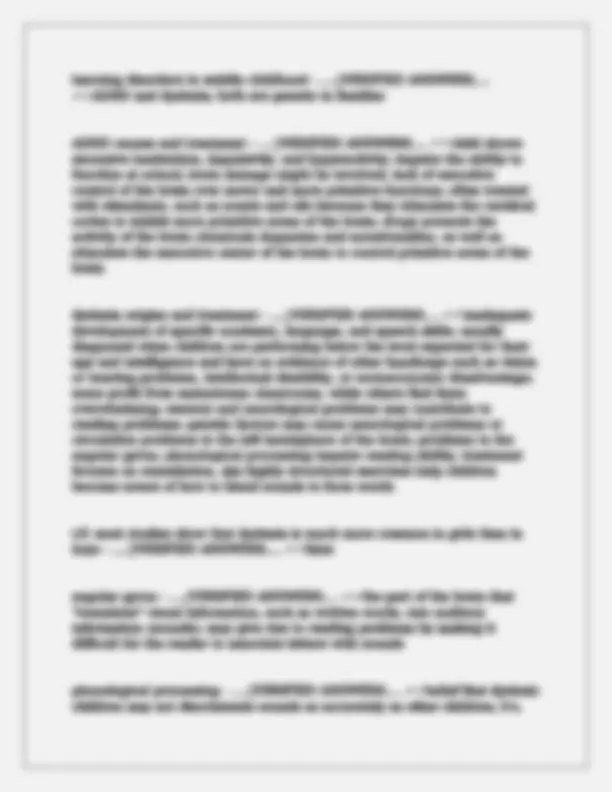
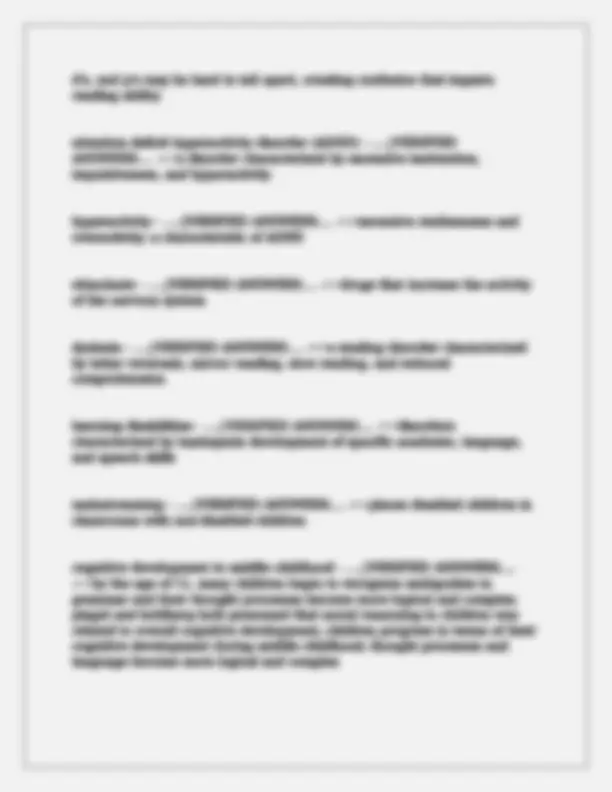
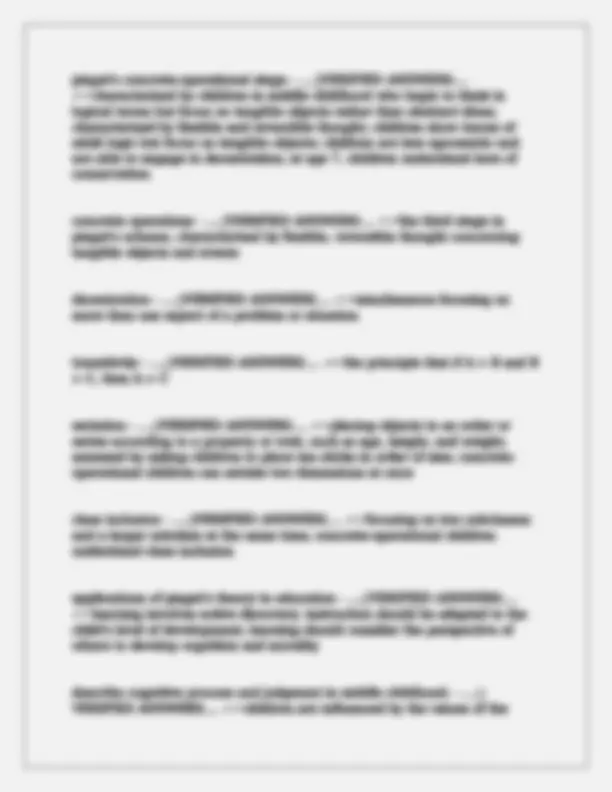
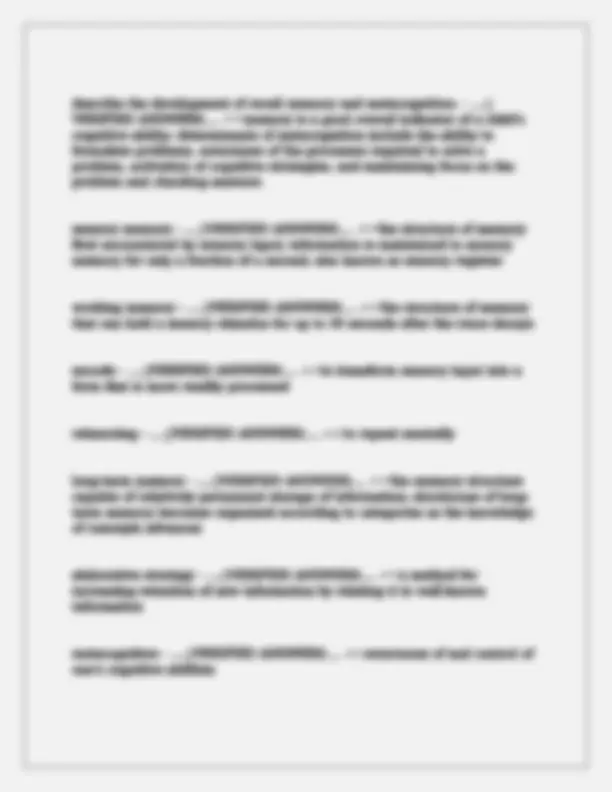

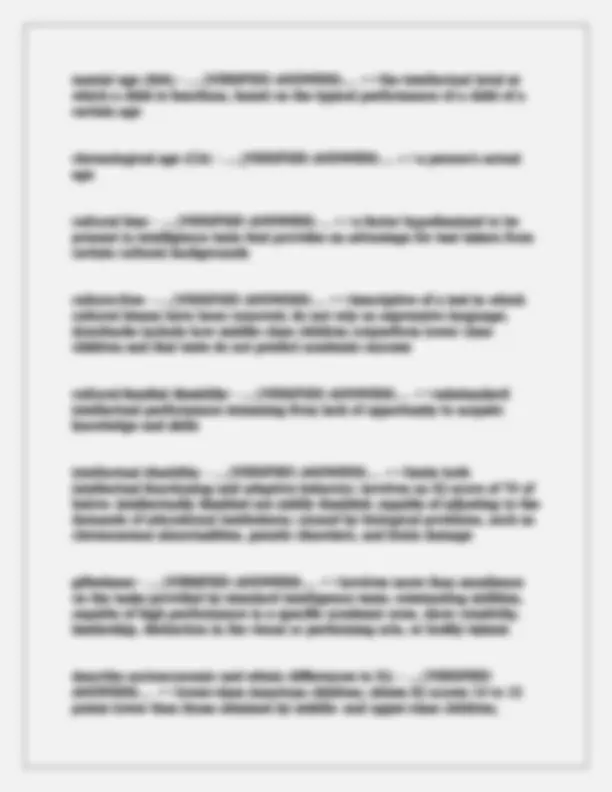
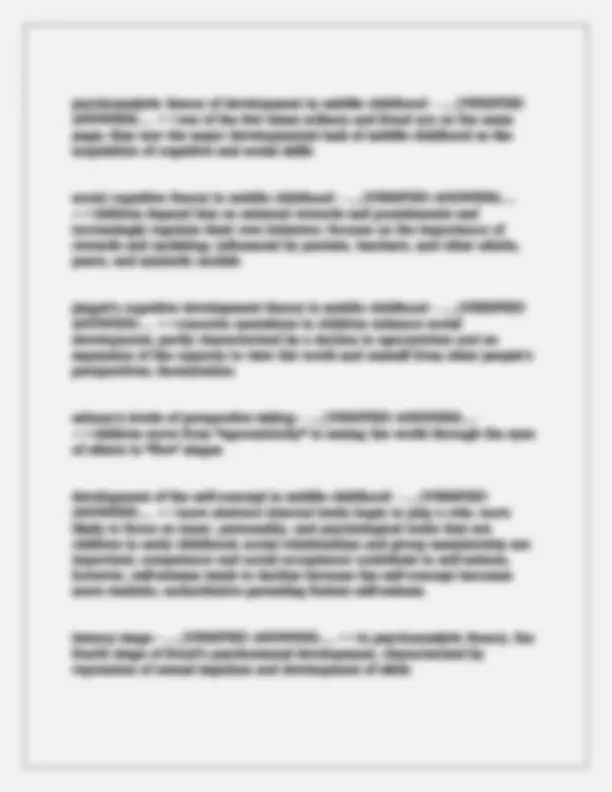
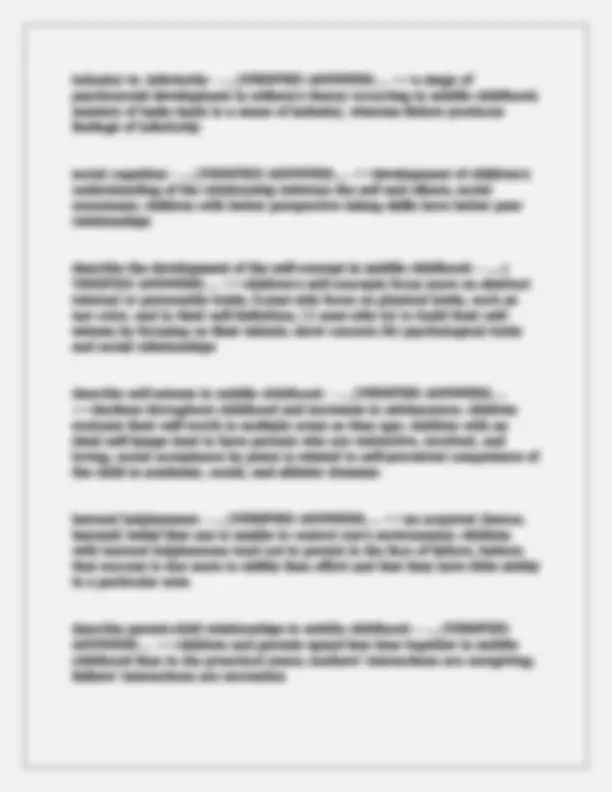
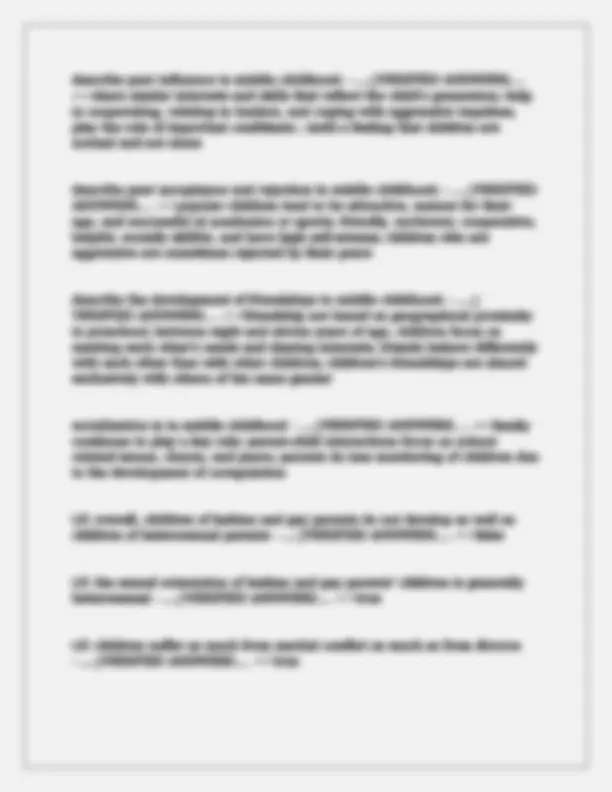
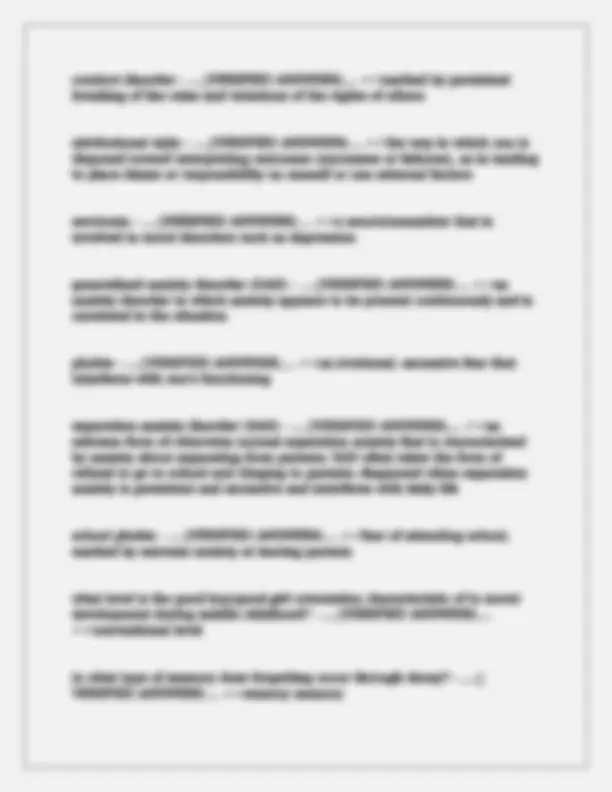
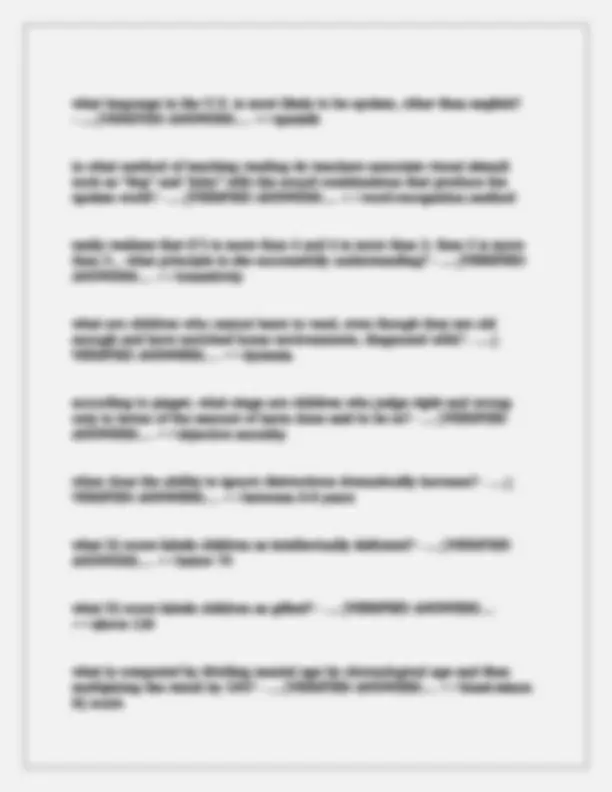
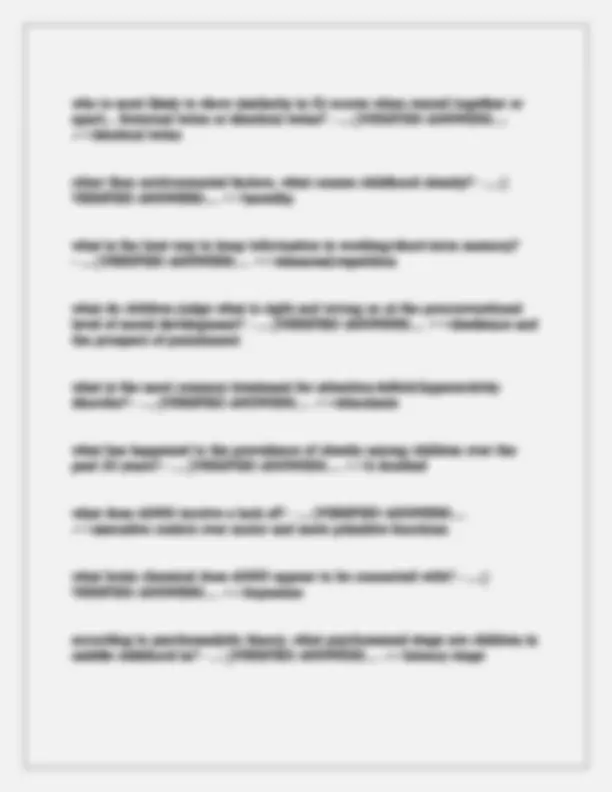
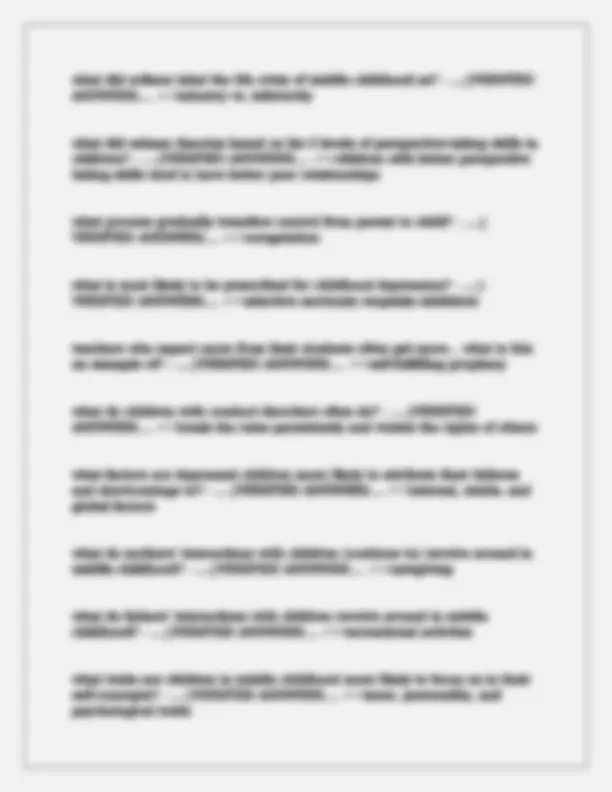

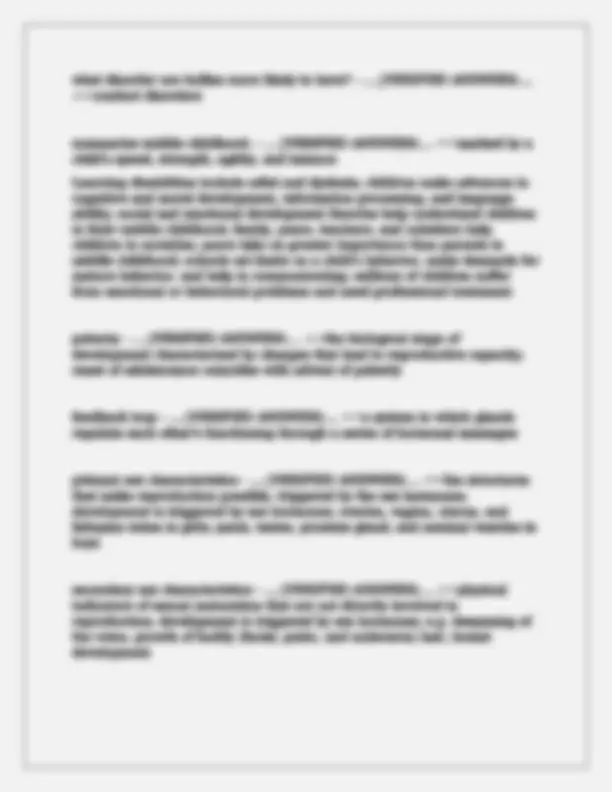

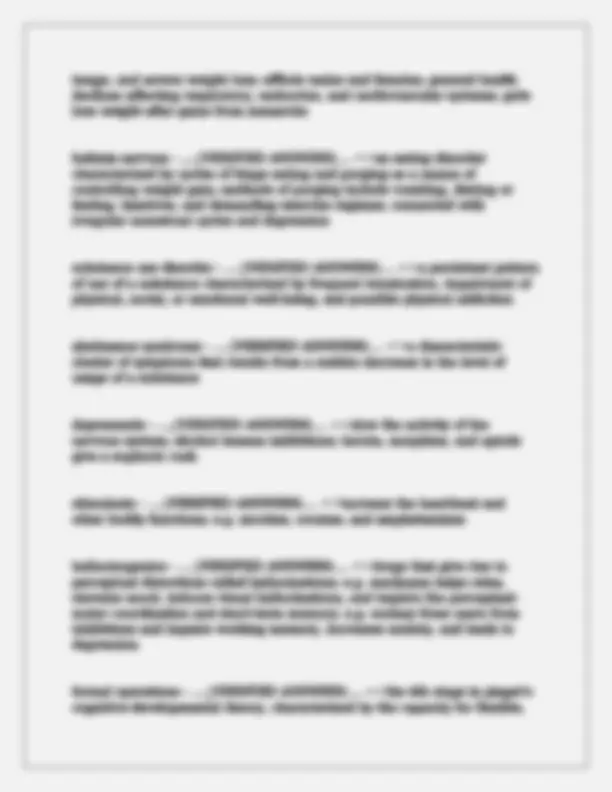
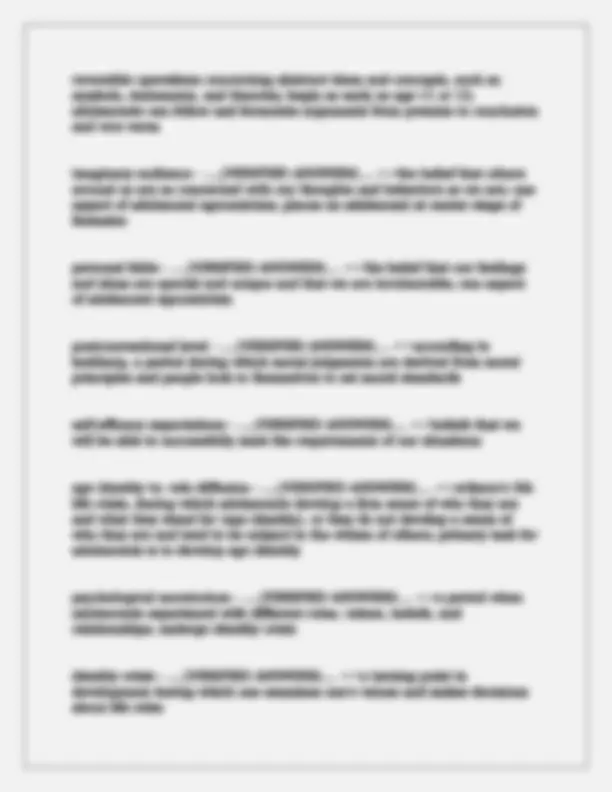
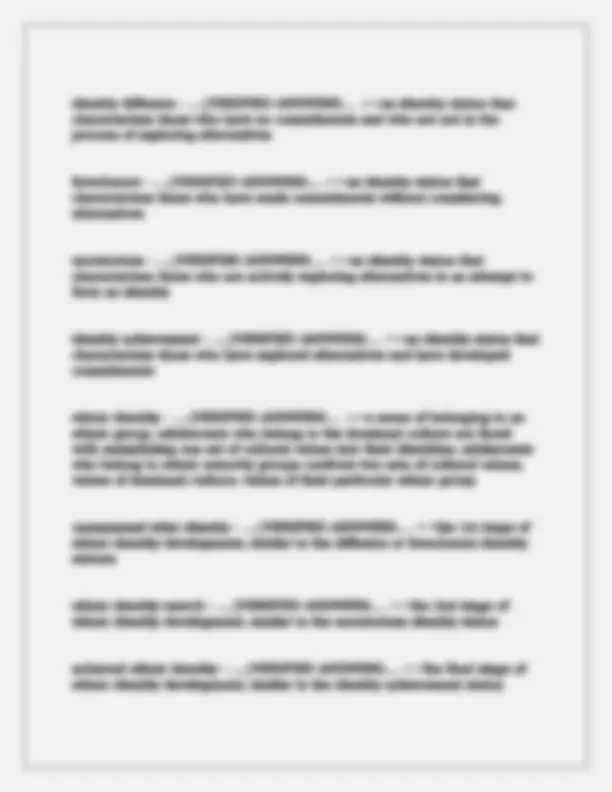
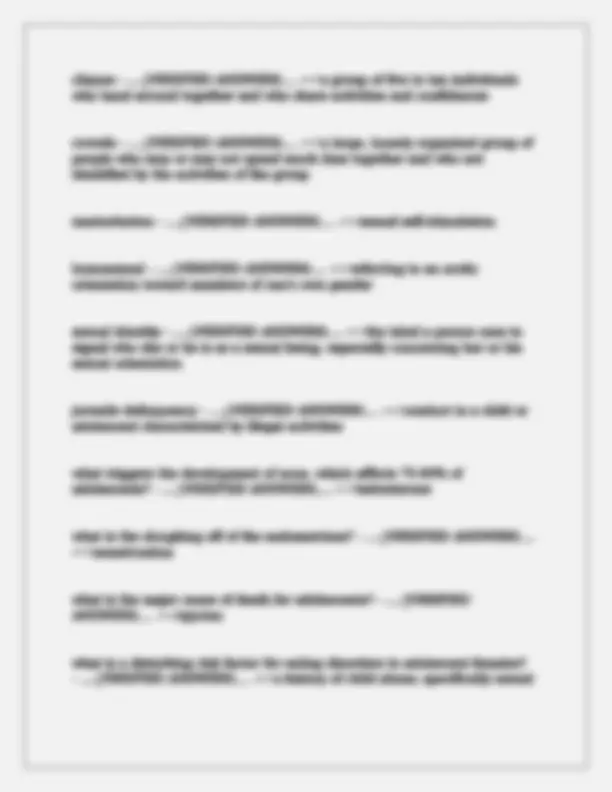
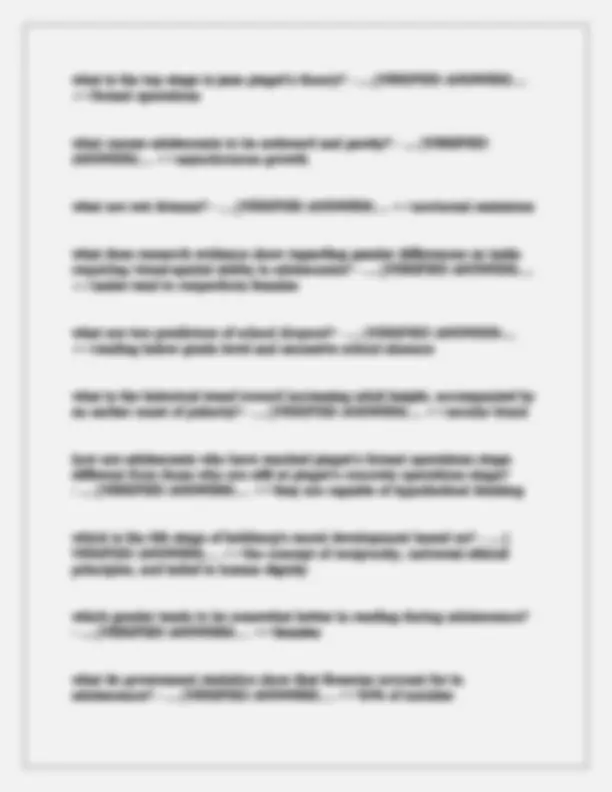
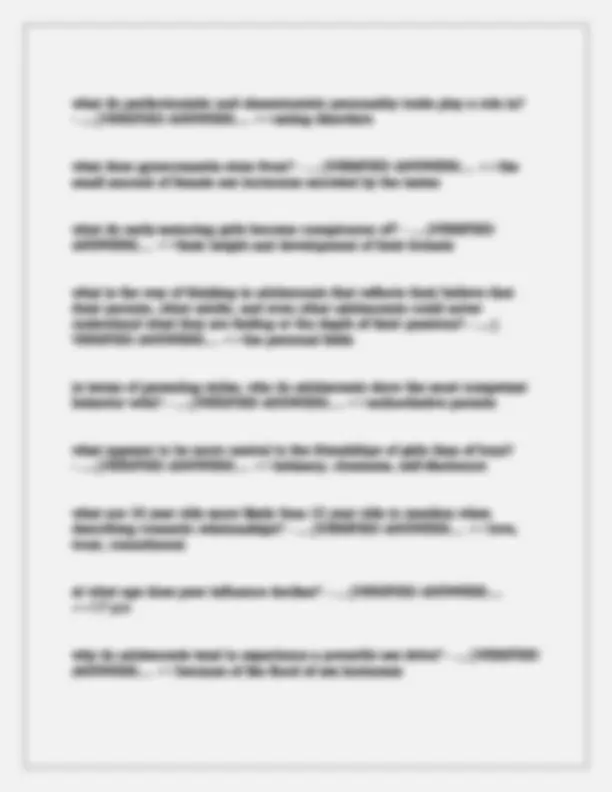
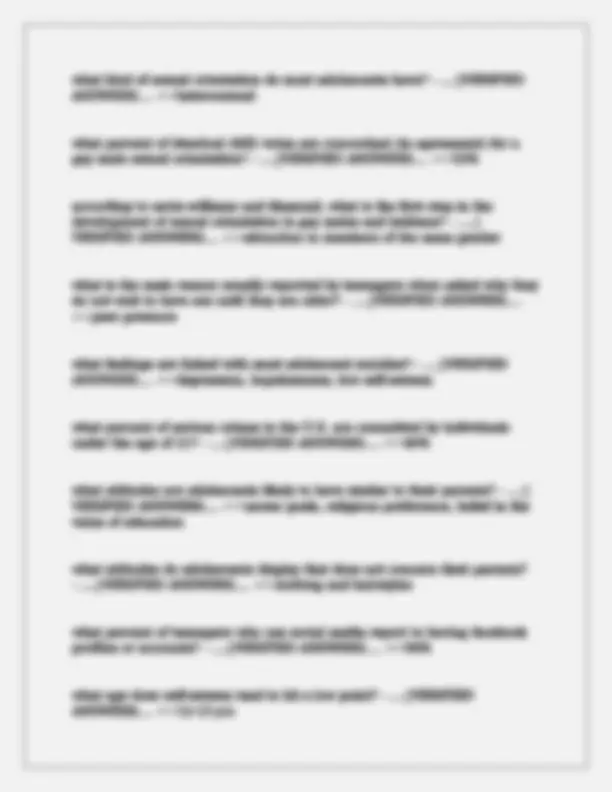
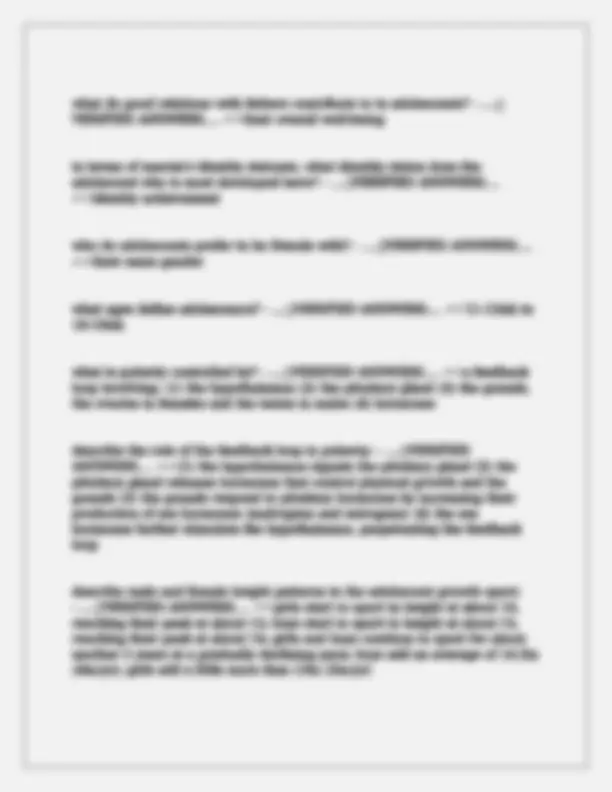

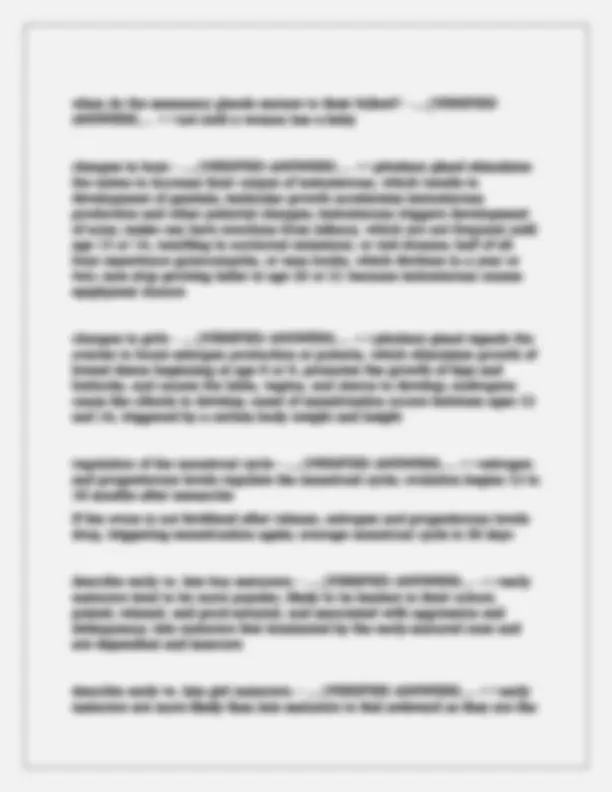
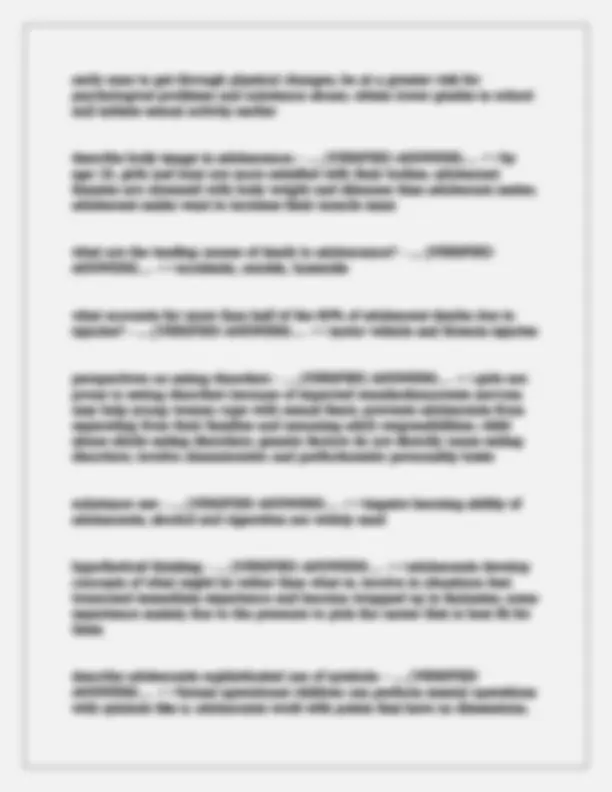
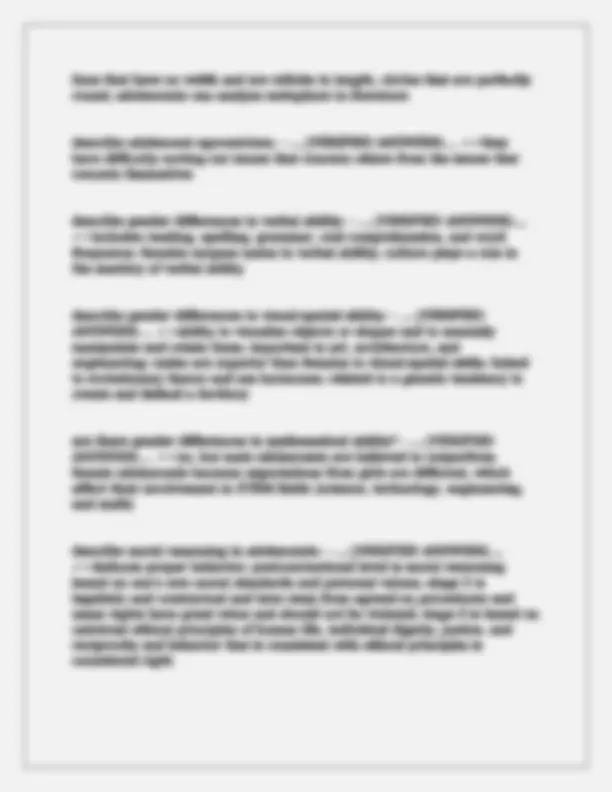
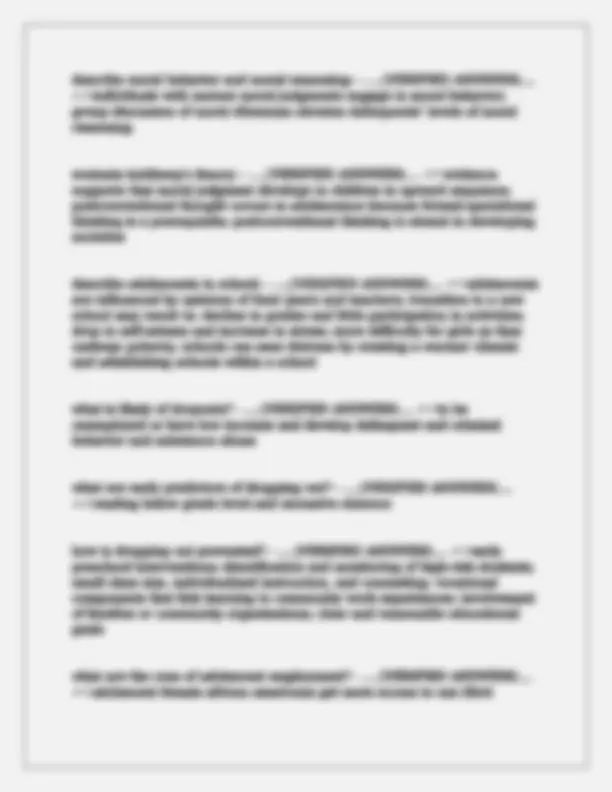
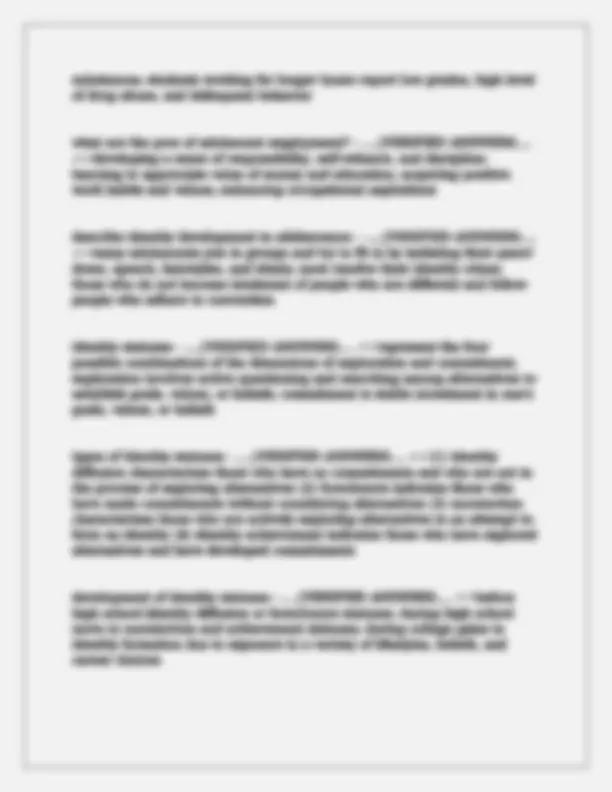
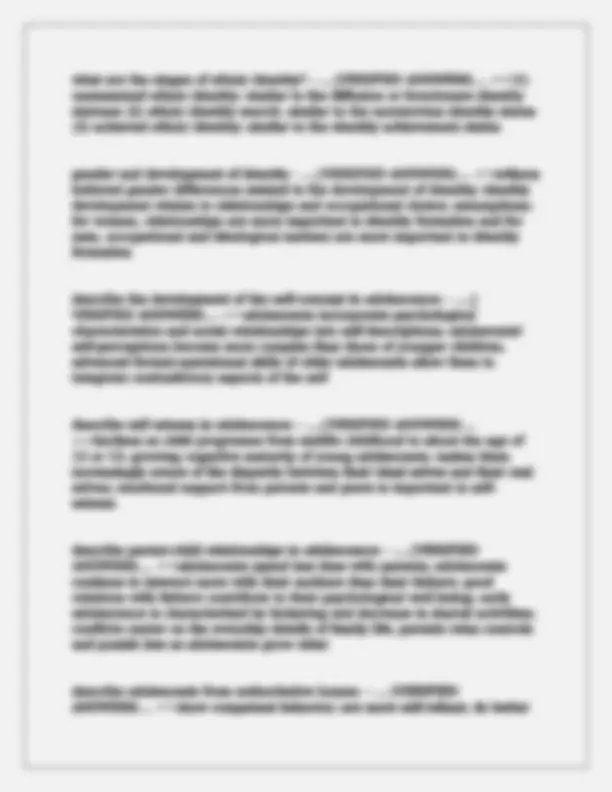
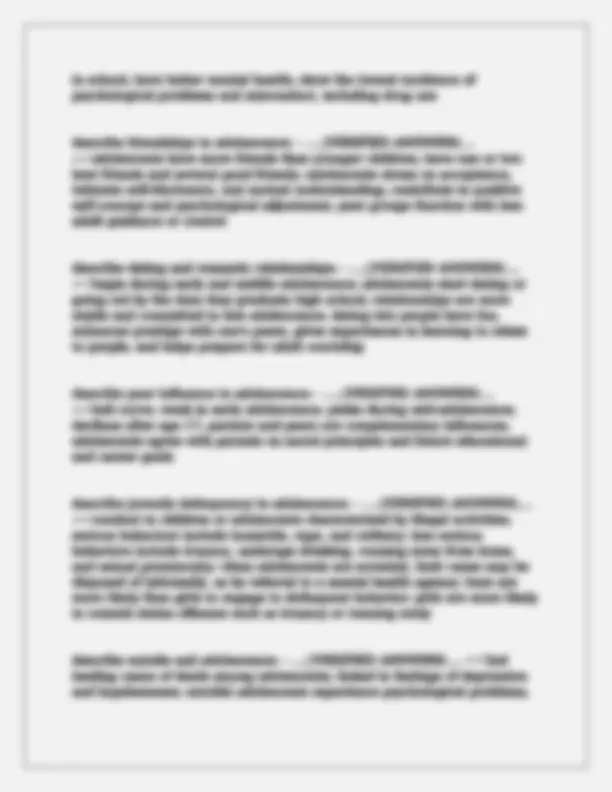
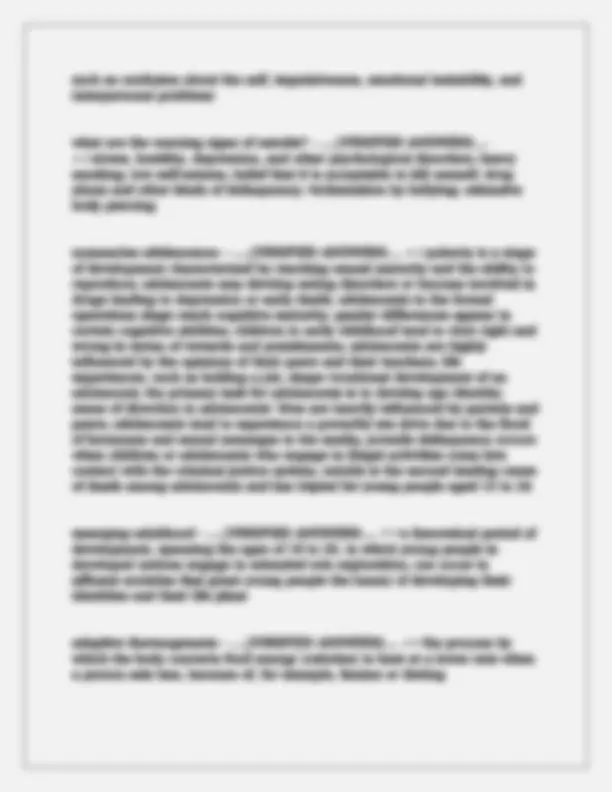
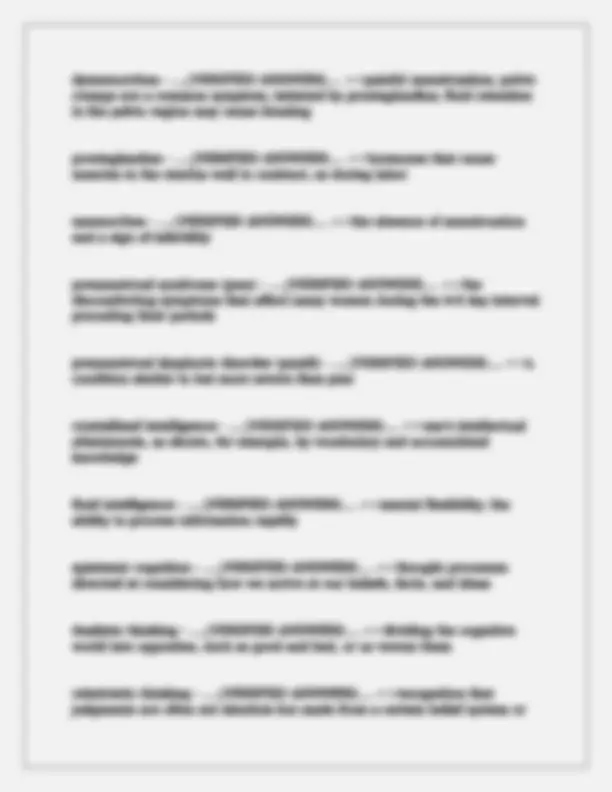
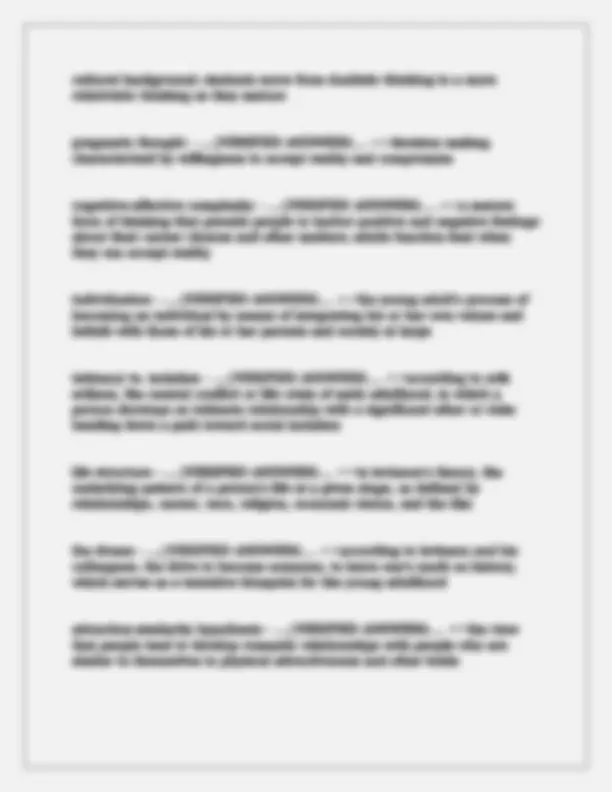
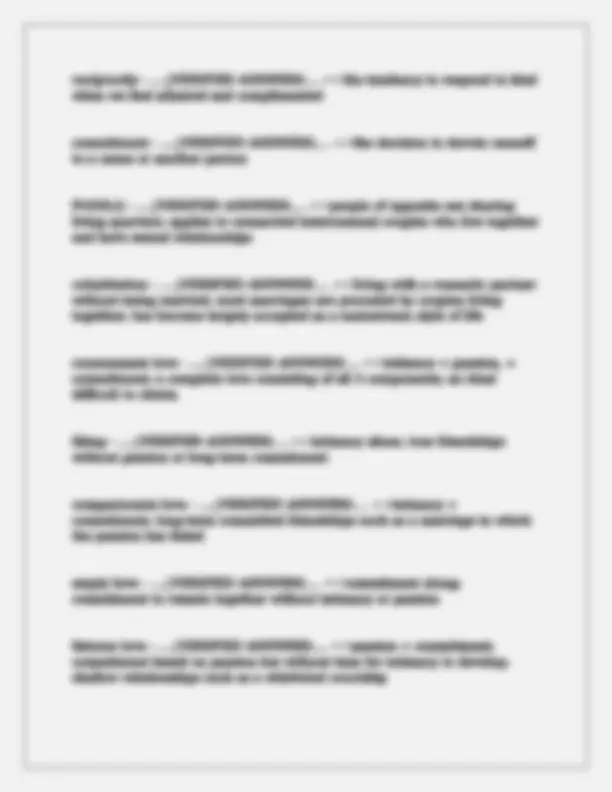
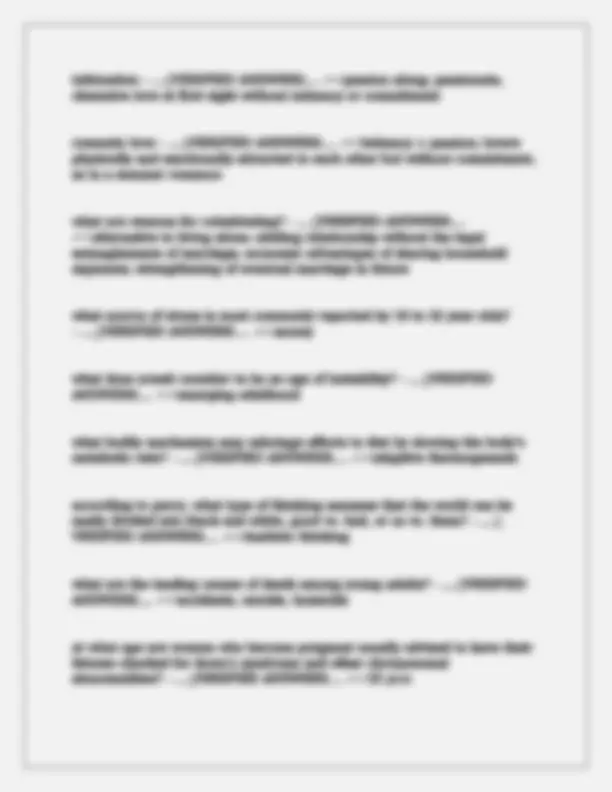
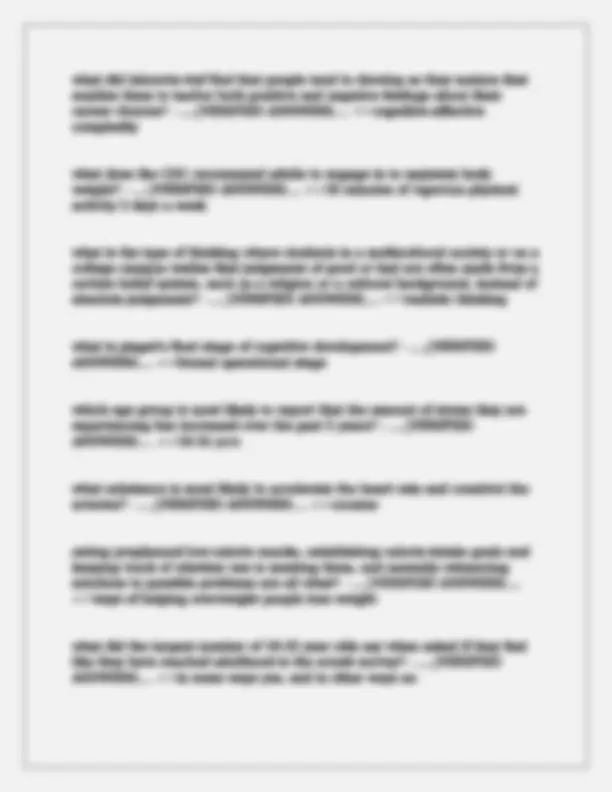

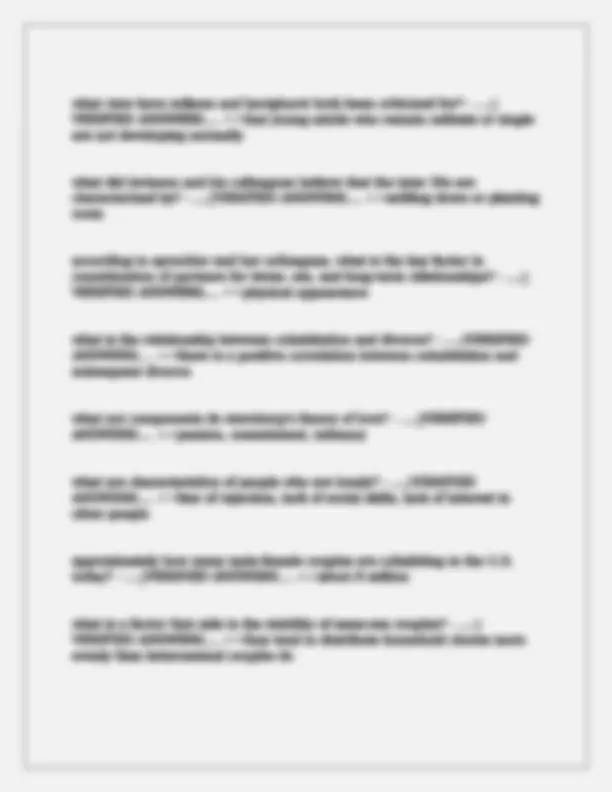

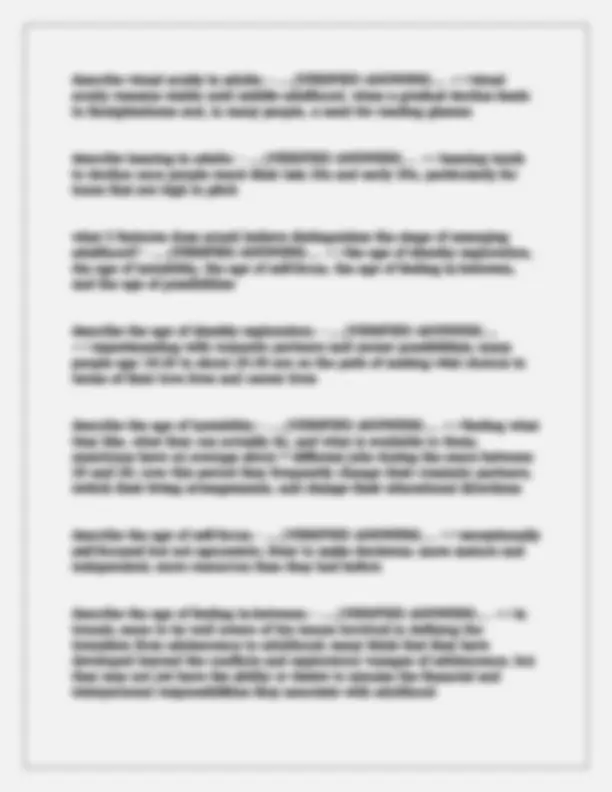
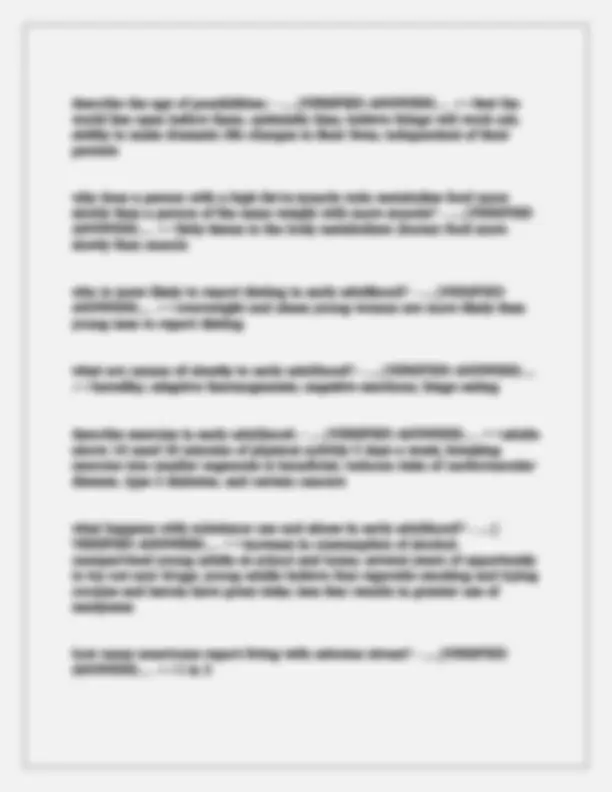
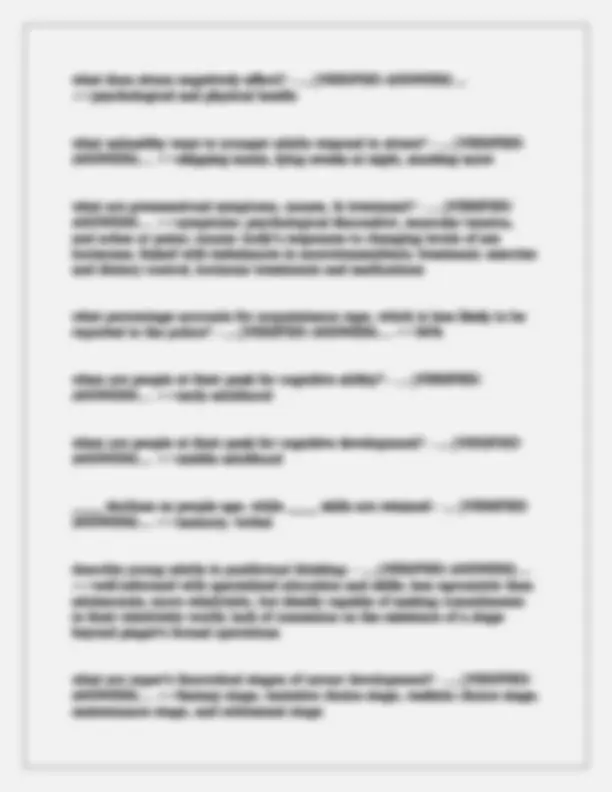
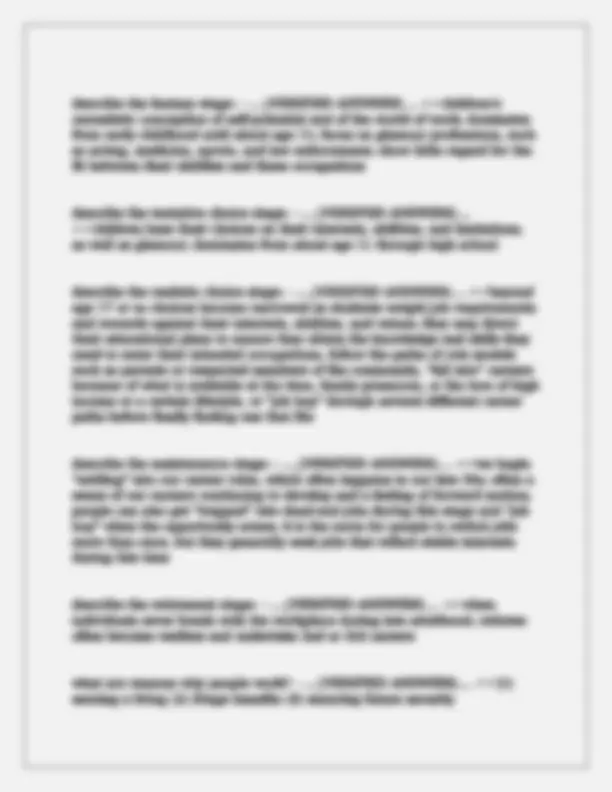
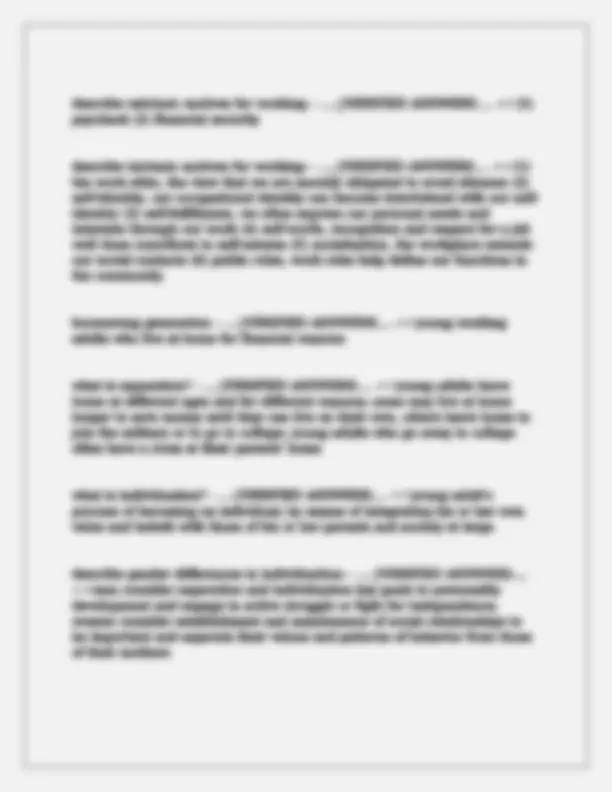
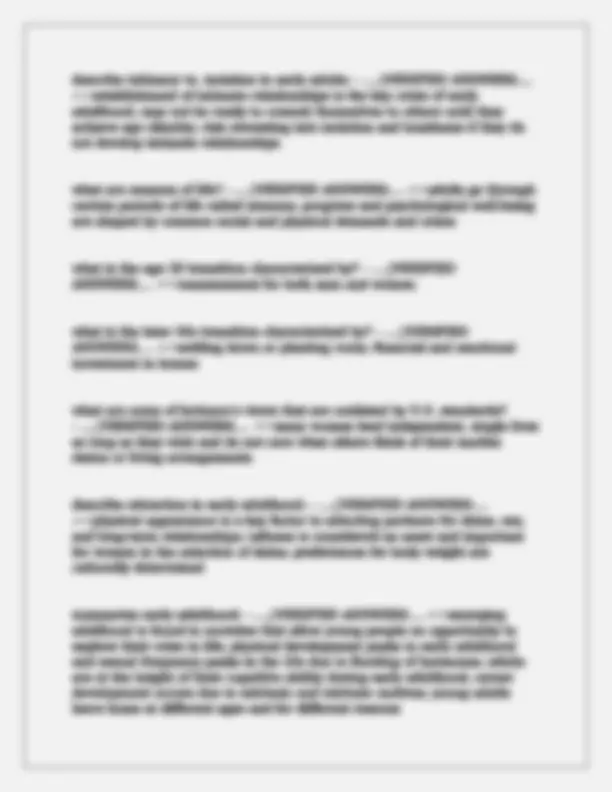
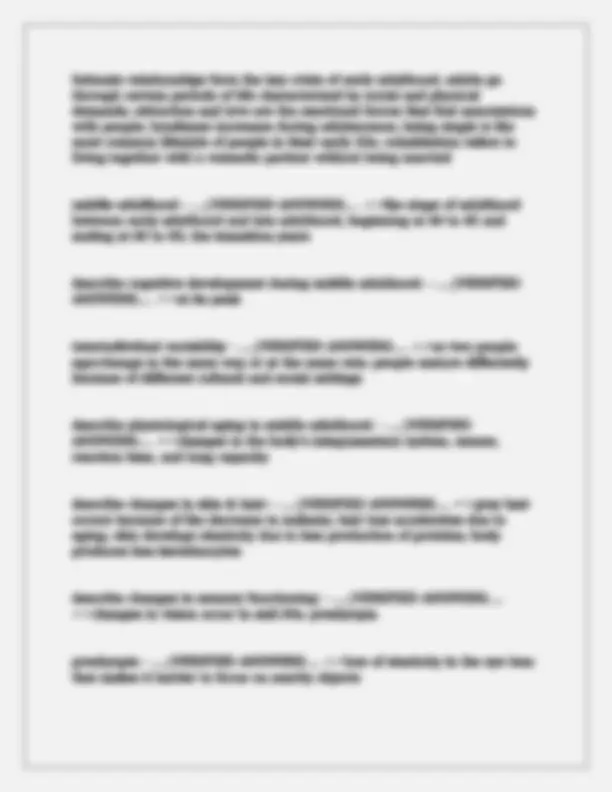

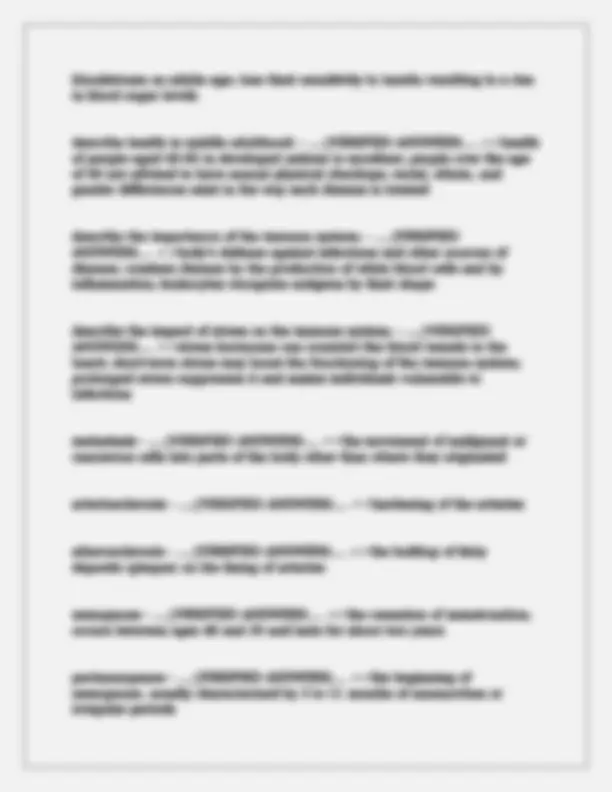
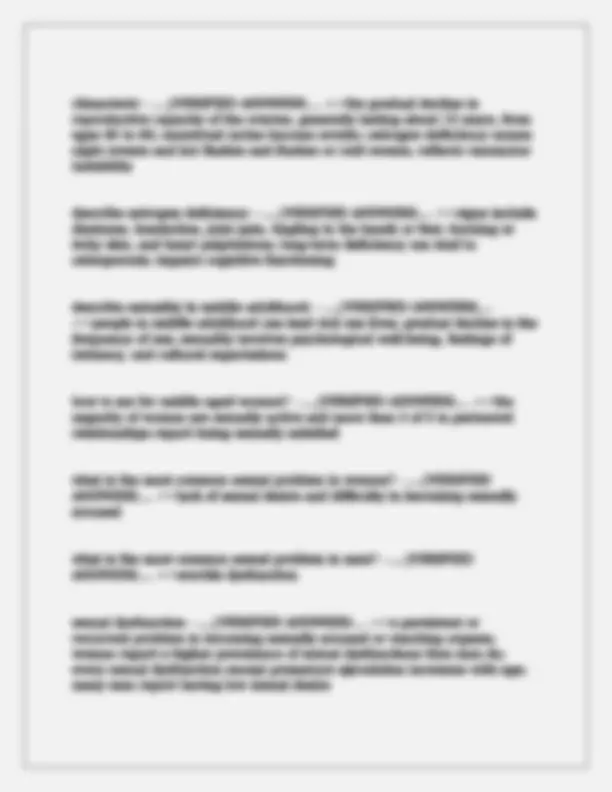
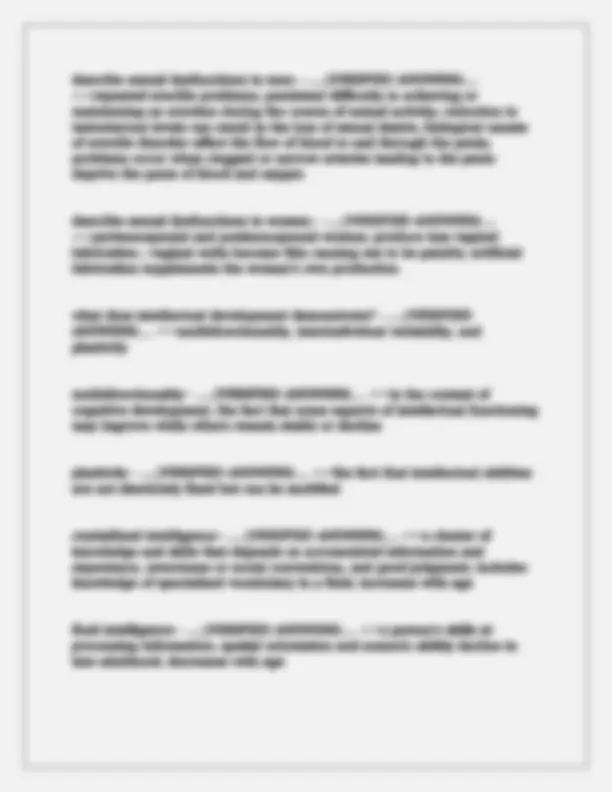
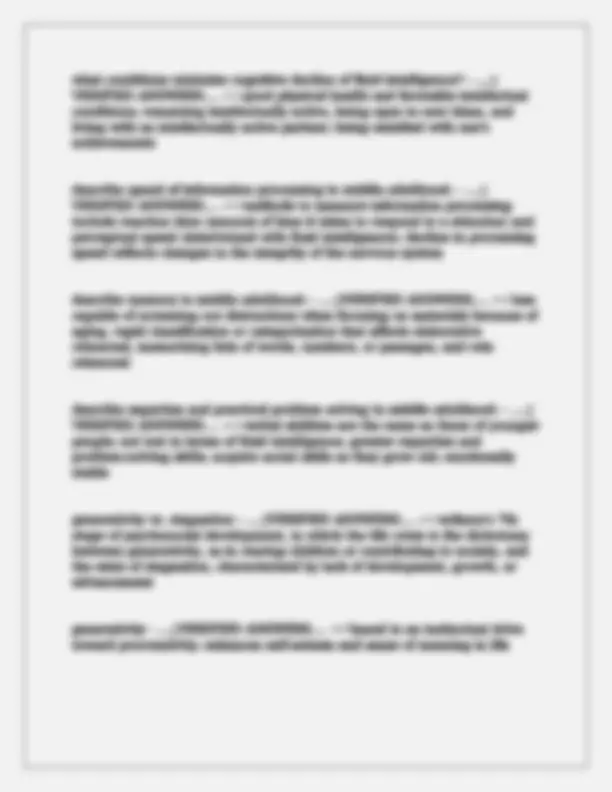
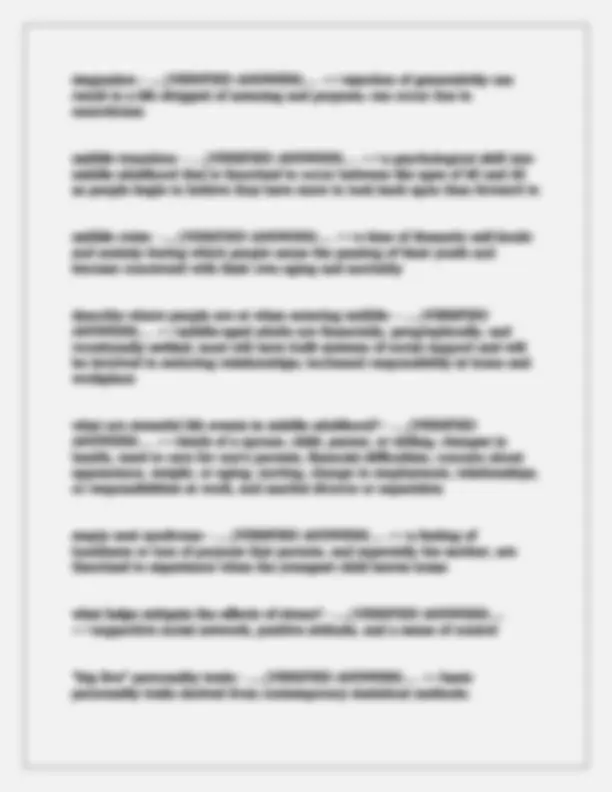
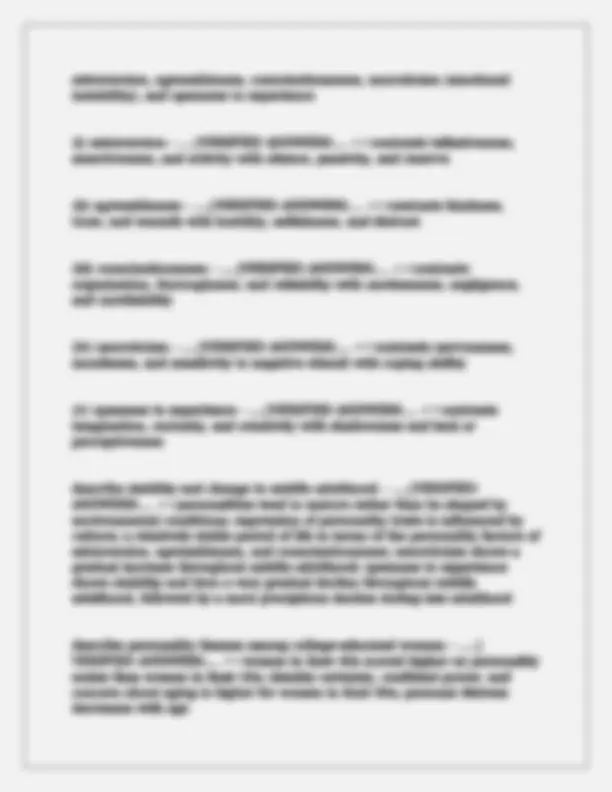

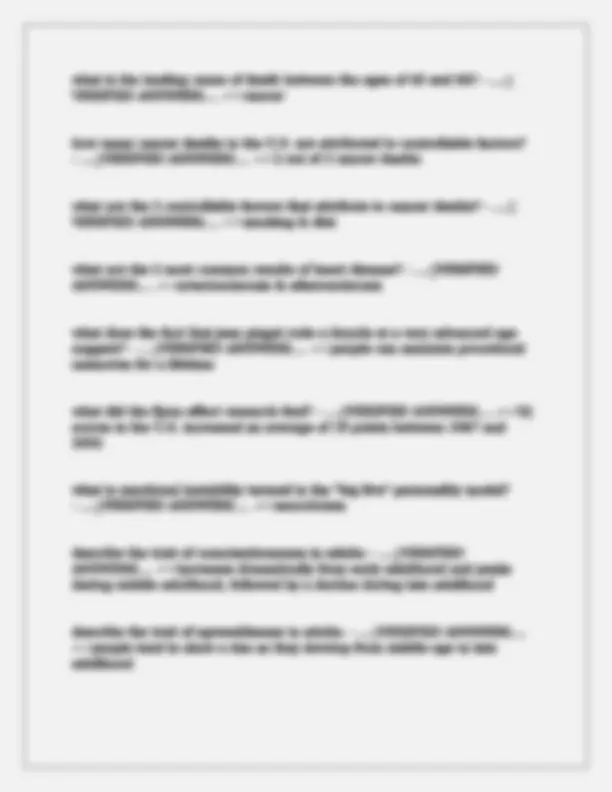
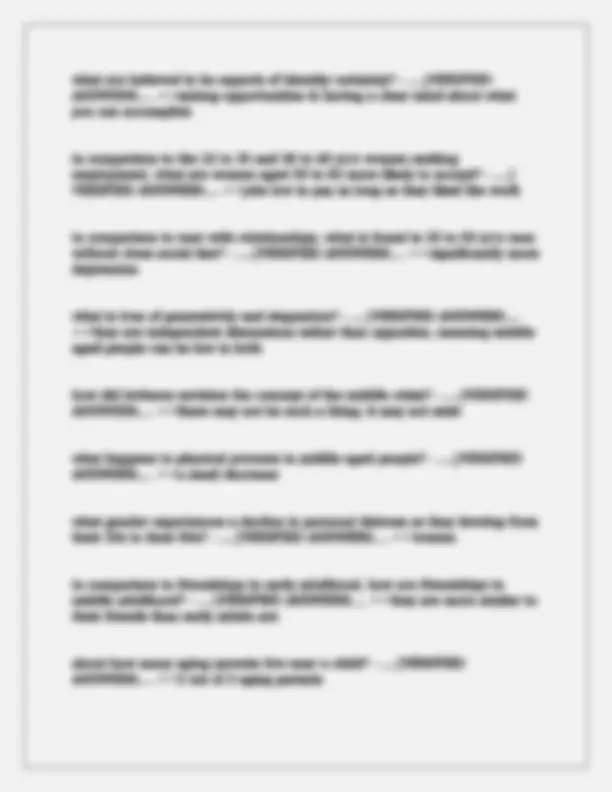
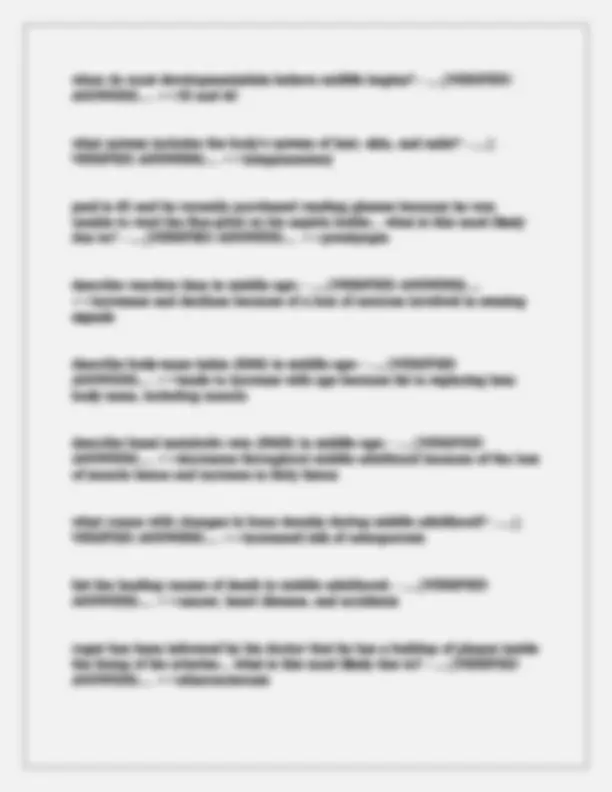
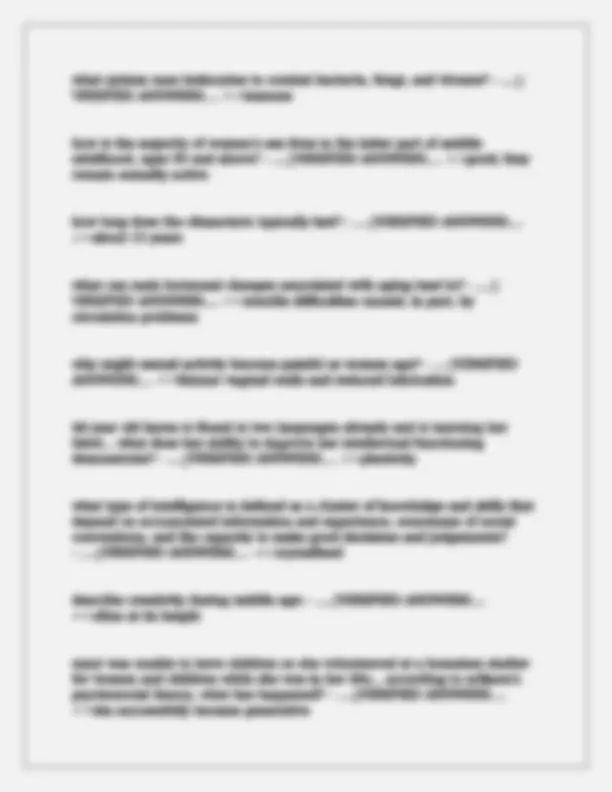
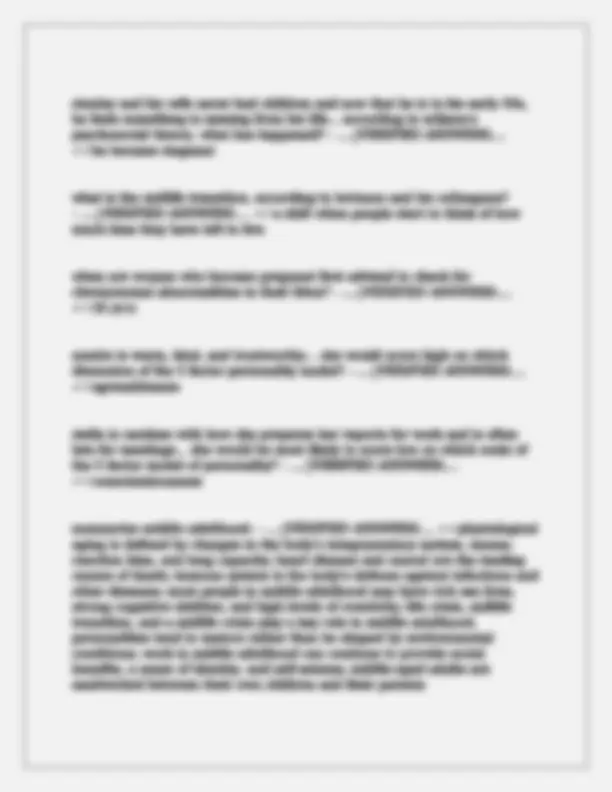
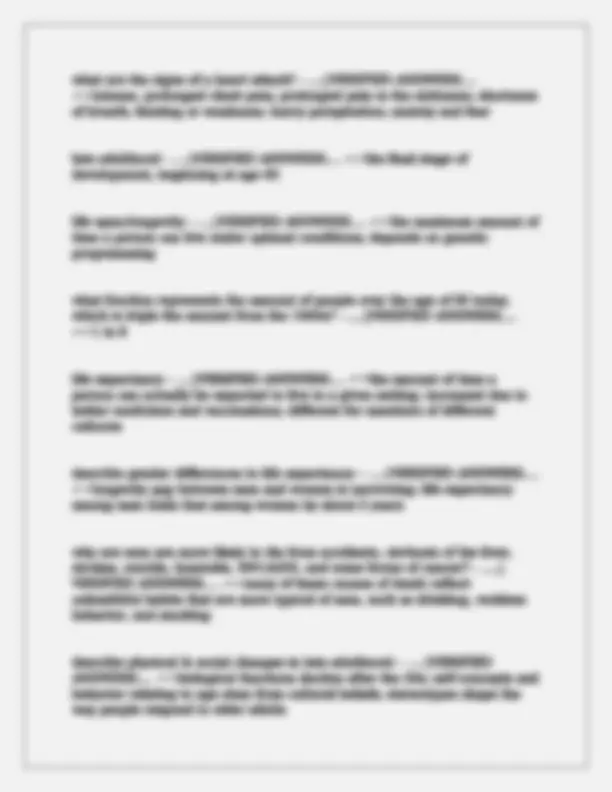
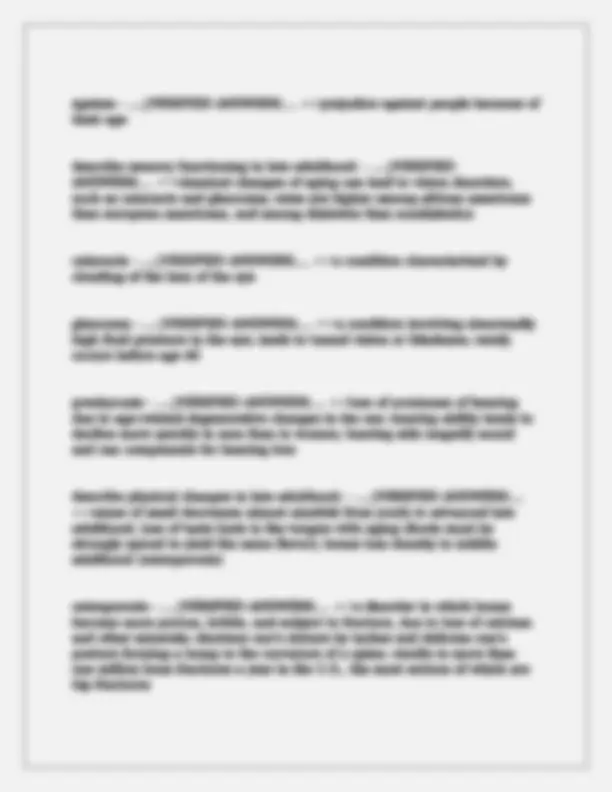
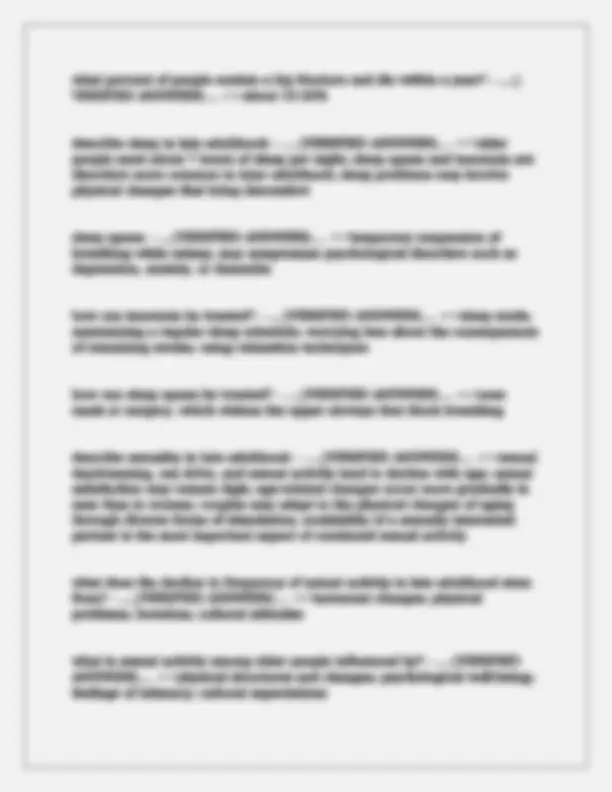
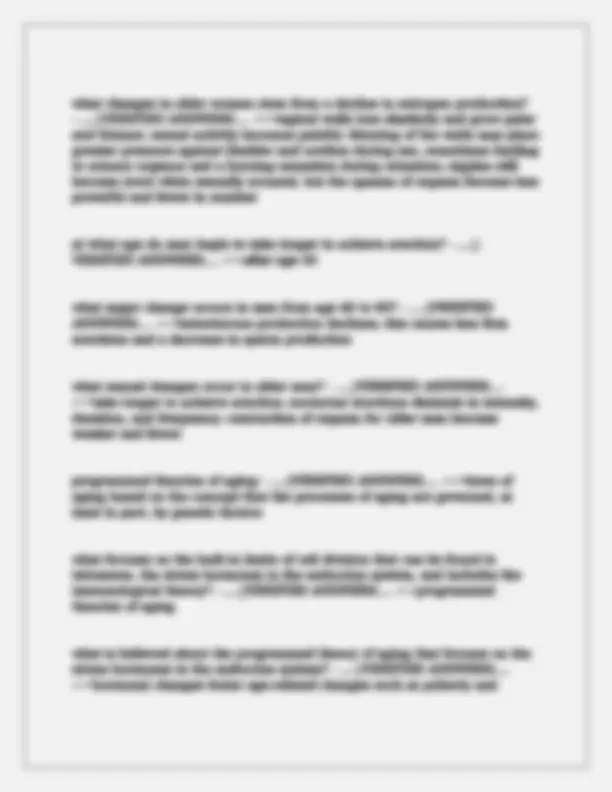
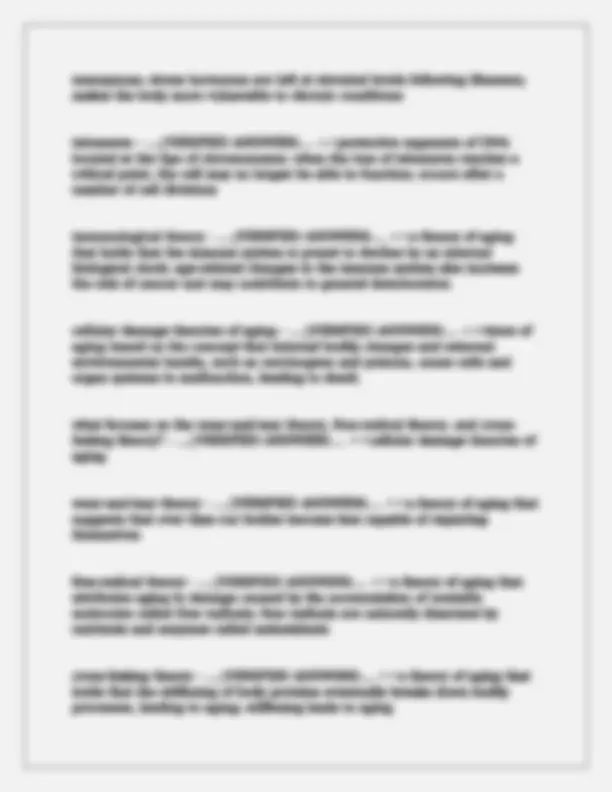
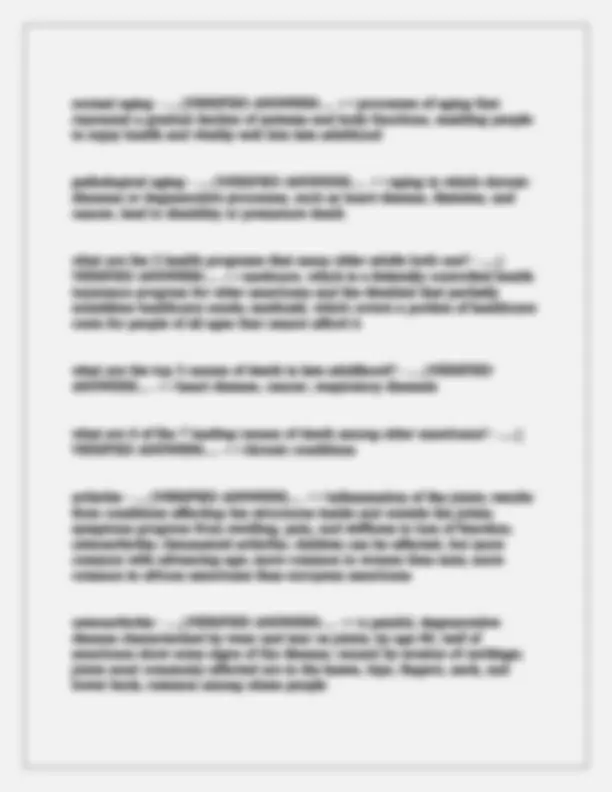
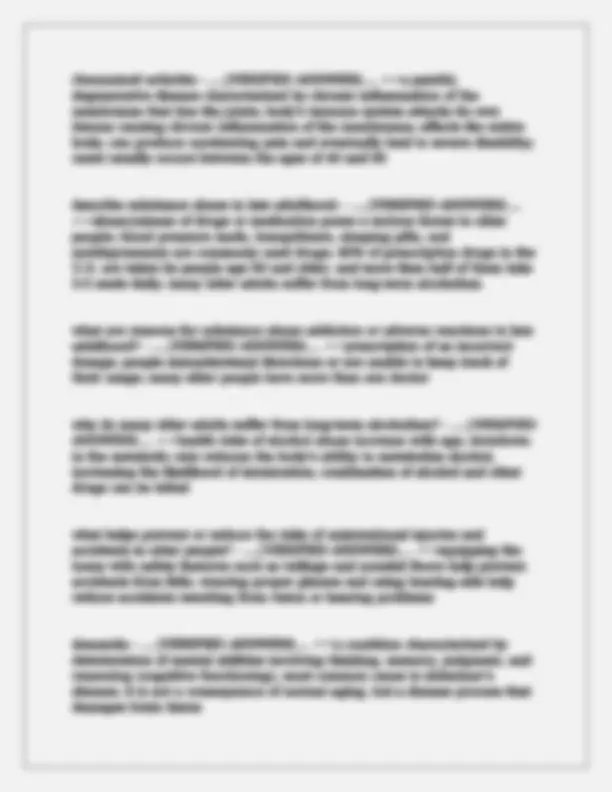
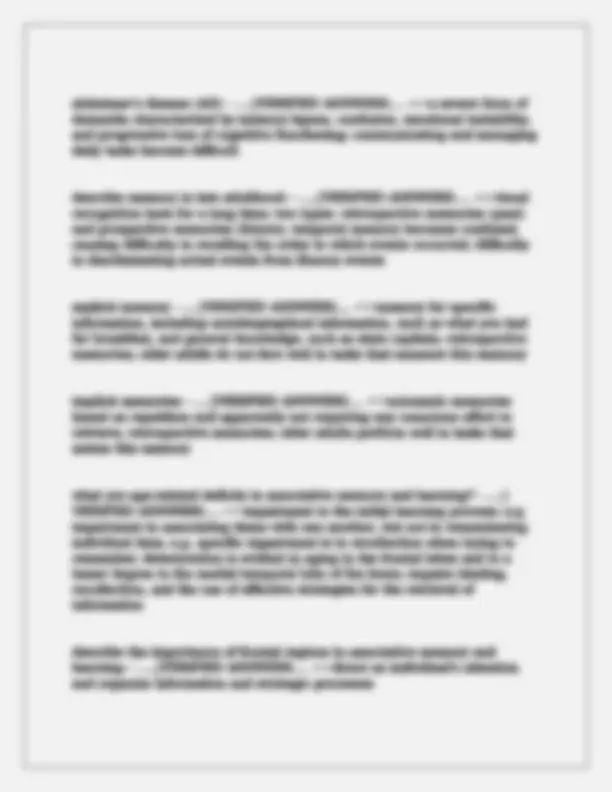
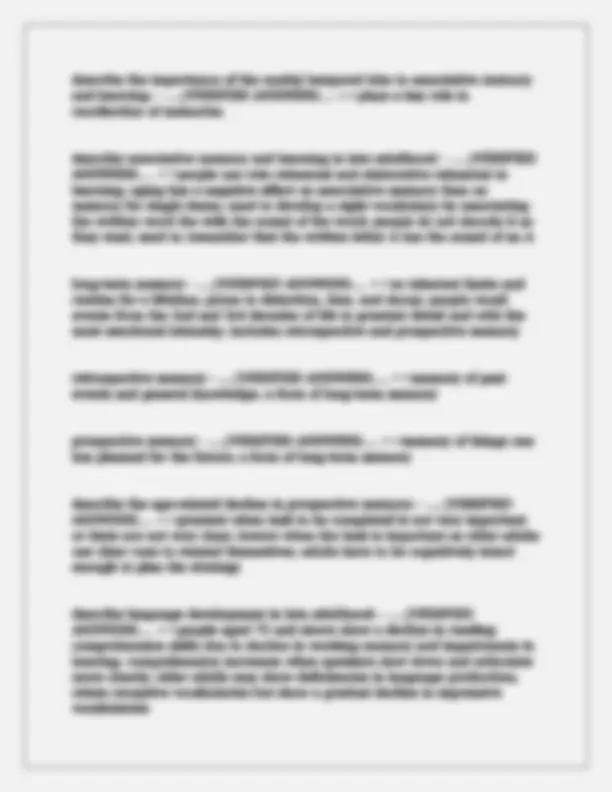
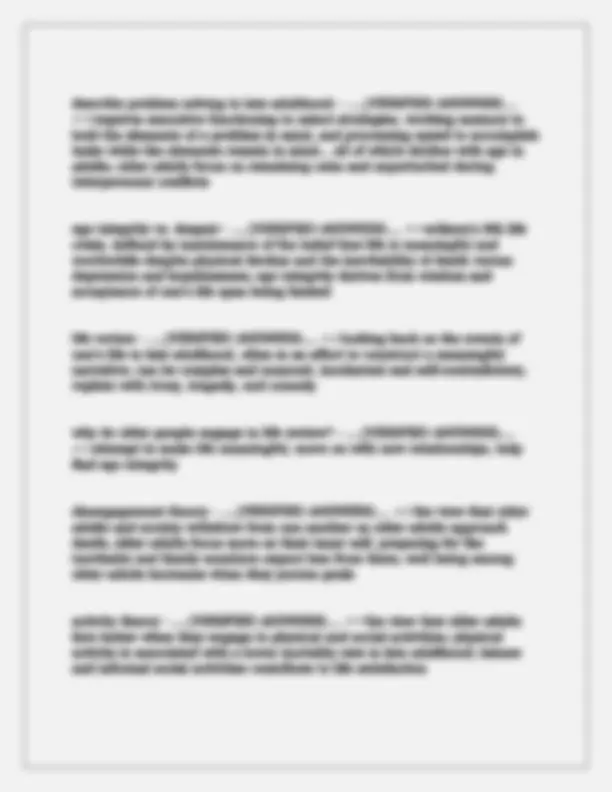
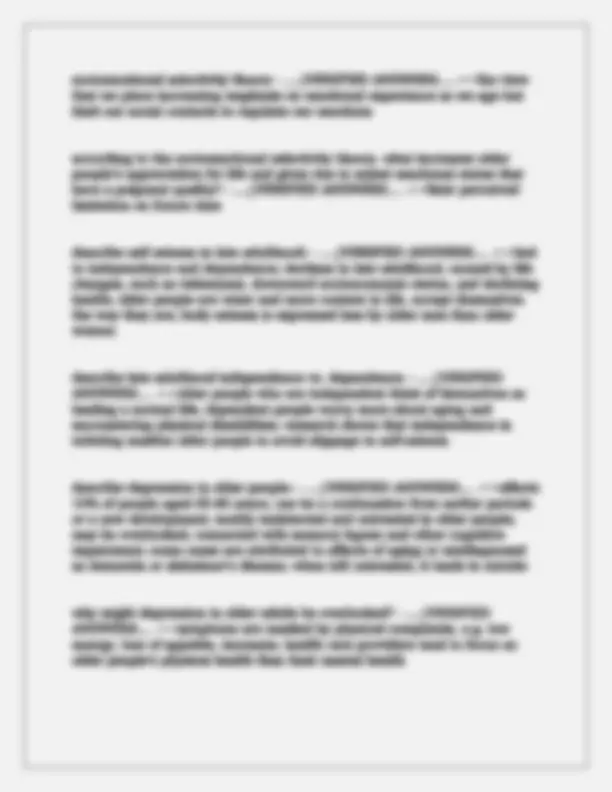
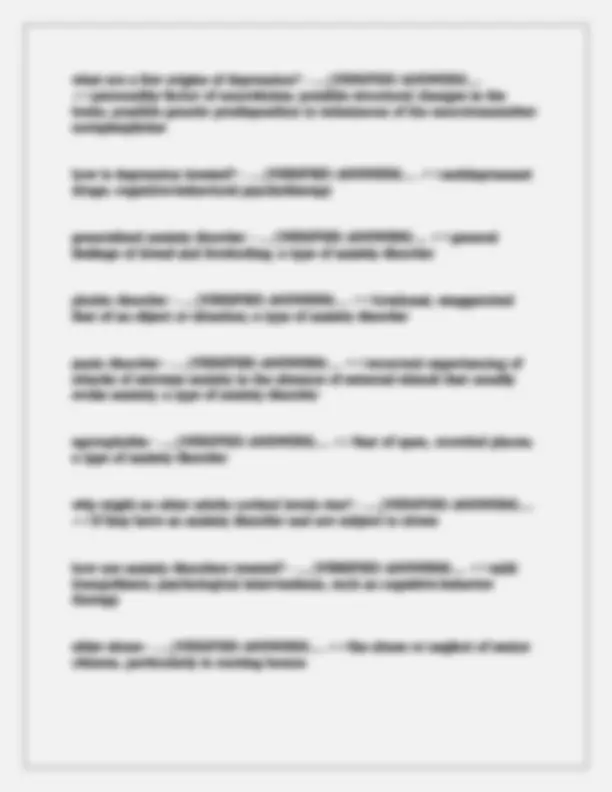
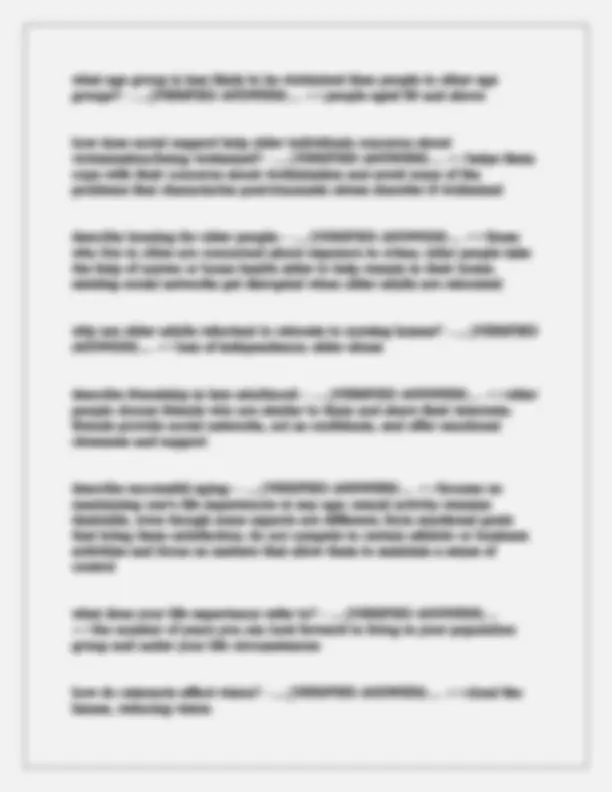
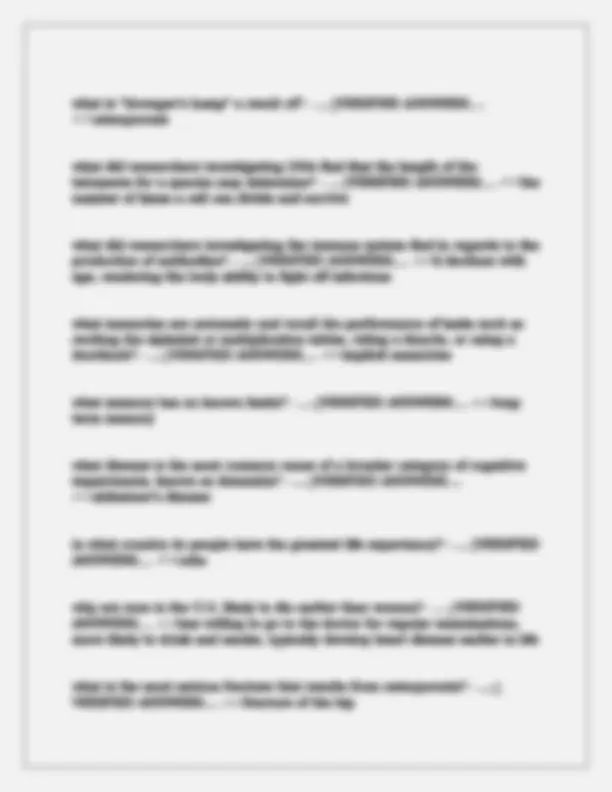
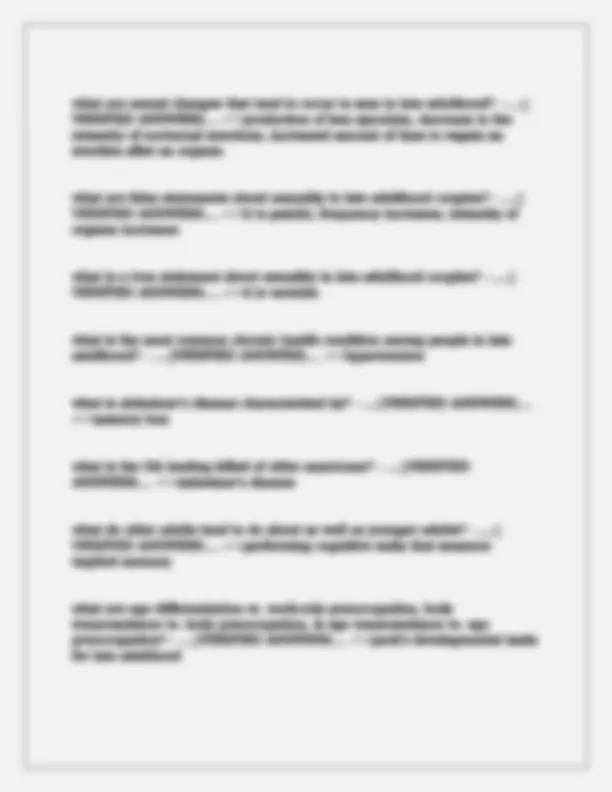
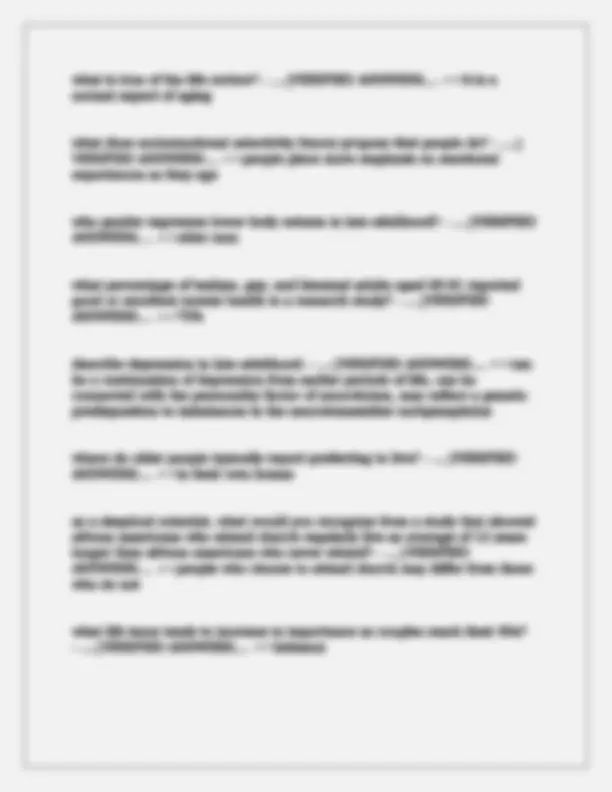
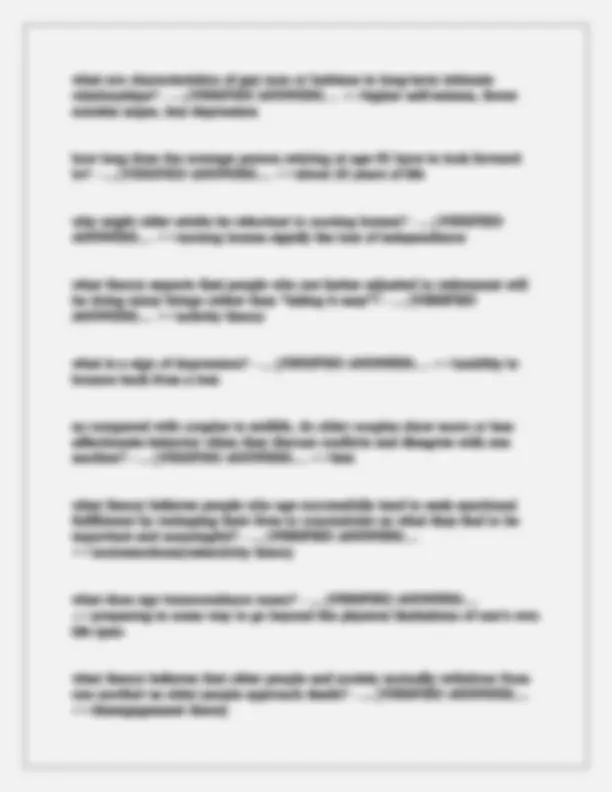
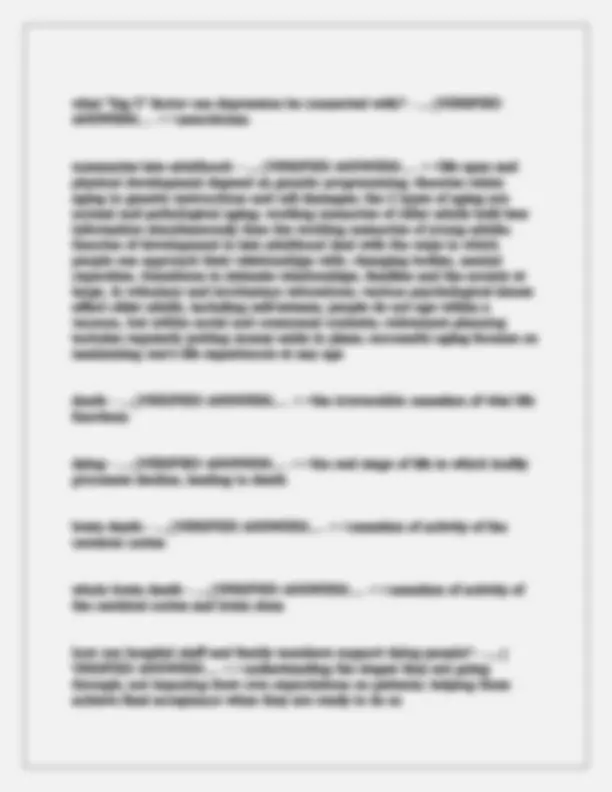
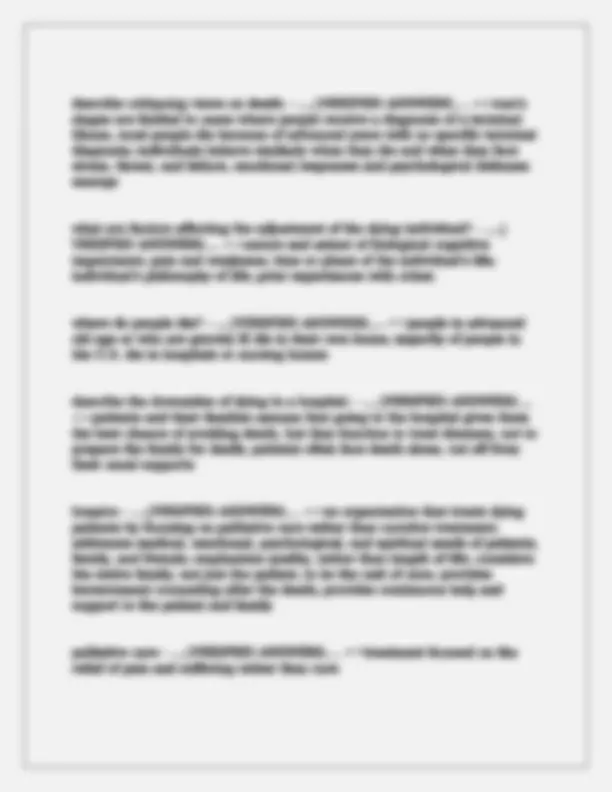
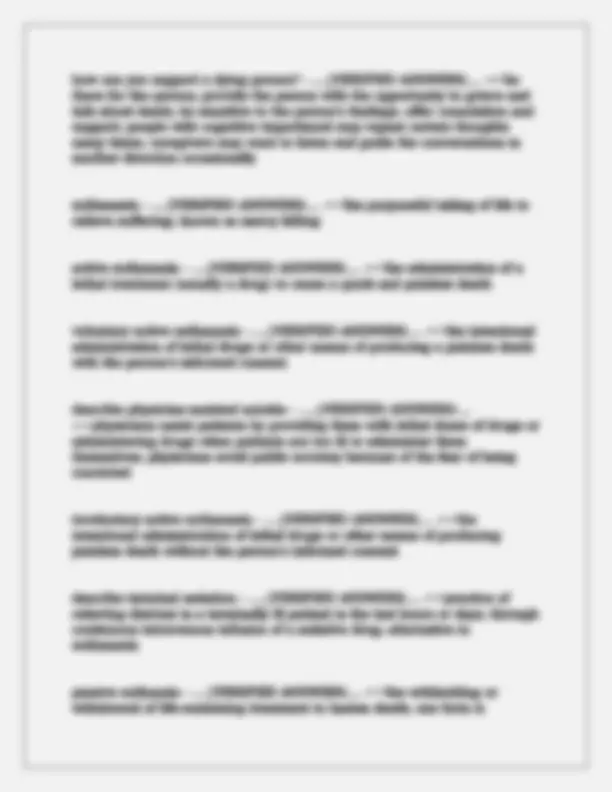

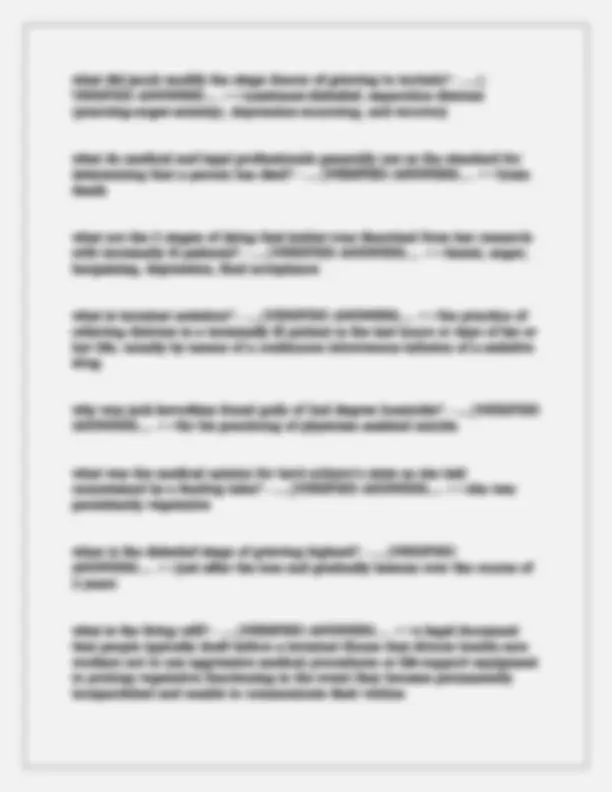
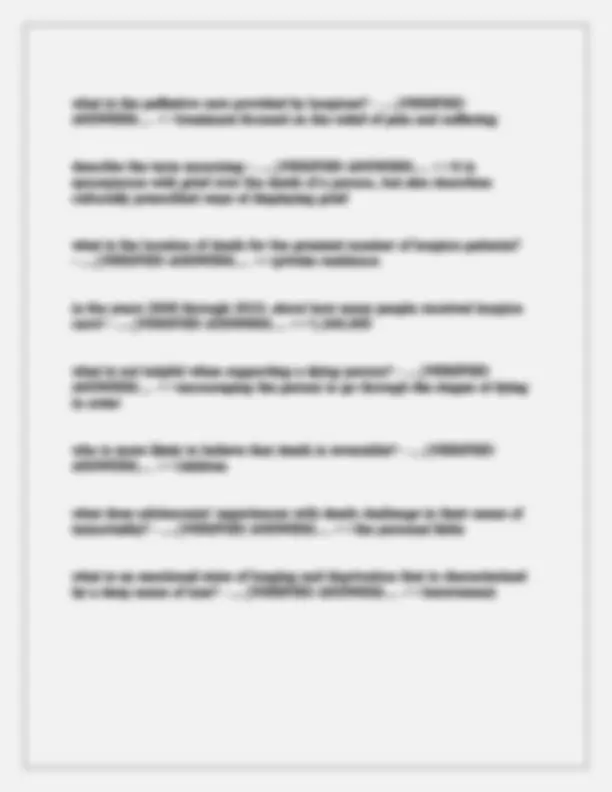


Study with the several resources on Docsity

Earn points by helping other students or get them with a premium plan


Prepare for your exams
Study with the several resources on Docsity

Earn points to download
Earn points by helping other students or get them with a premium plan
Community
Ask the community for help and clear up your study doubts
Discover the best universities in your country according to Docsity users
Free resources
Download our free guides on studying techniques, anxiety management strategies, and thesis advice from Docsity tutors
A comprehensive overview of key developmental milestones during middle childhood, focusing on physical, motor, cognitive, and moral development. It includes questions and answers covering topics such as growth spurts, motor skills, learning disorders, piaget's theory of cognitive development, and kohlberg's theory of moral development. A valuable resource for students studying child development or related fields.
Typology: Exams
1 / 92

This page cannot be seen from the preview
Don't miss anything!





















































































ages of middle childhood - .... 🔰 VERIFIED ANSWERS.... ✔✔ 6 to 12 years old (kindergarten to sixth grade) physical growth in middle childhood - .... 🔰 VERIFIED ANSWERS.... ✔✔ grow 2 inches in height per and gain 5-7 pounds in weight per year; boys are slightly heavier and taller than girls through age 9 or 10 until girls begin their adolescent growth spurt and surpass boys in height and weight until about 13 or 14; girls develop more fat; boys develop more muscle childhood obesity - .... 🔰 VERIFIED ANSWERS.... ✔✔ heredity, sedentary habits, and environmental factors play a role in obesity and foster weight gain; overweight children usually do not outgrow baby fat growth spurt - .... 🔰 VERIFIED ANSWERS.... ✔✔ a period during which growth advances at a dramatically rapid rate compared with other periods motor development in middle childhood - .... 🔰 VERIFIED ANSWERS.... ✔✔ gross and fine motor development, such as speed, strength, agility, and balance increase as pathways that connect the cerebellum to the cortex become more myelinated what happens to reaction time in through childhood? - .... 🔰 VERIFIED ANSWERS.... ✔✔ it improves from early childhood to about age 18 describe gross motor skills in middle childhood: - .... 🔰 VERIFIED ANSWERS.... ✔✔ gain balance, coordination, and strength; muscles grow stronger; neural pathways that connect the cerebellum to the cortex are more myelinated
describe fine motor skills in middle childhood: - .... 🔰 VERIFIED ANSWERS.... ✔✔ performance of basic chores improves by the age of 6 to 7 describe gender differences in motor activities: - .... 🔰 VERIFIED ANSWERS.... ✔✔ boys and girls perform similarly in most motor activities; boys have more forearm strength, aids them in throwing a ball or swinging a bat; girls have greater limb coordination and overall flexibility, aids them in dancing, gymnastics, and balancing t/f: children in middle childhood should not be given chores - .... 🔰 VERIFIED ANSWERS.... ✔✔ false t/f: by age six or seven, children are usually capable of pedaling and balancing on a bicycle - .... 🔰 VERIFIED ANSWERS.... ✔✔ true sensorimotor abilities - .... 🔰 VERIFIED ANSWERS.... ✔✔ refined by experience; there are also inborn differences (some people have better visual acuity, depth perception, or coordination that others) gender differences in physical activities during middle childhood - .... 🔰 VERIFIED ANSWERS.... ✔✔ become increasingly stereotyped by children as being masculine or feminine; boys have slightly greater overall strength; girls have better coordination and flexibility t/f: most U.S. children are not physically fit, in part because of the amount of time spent watching TV - .... 🔰 VERIFIED ANSWERS.... ✔✔ true reaction time - .... 🔰 VERIFIED ANSWERS.... ✔✔ the amount of time required to respond to a stimulus; in middle childhood, it decreases and improves
d's, and p's may be hard to tell apart, creating confusion that impairs reading ability attention deficit hyperactivity disorder (ADHD) - .... 🔰 VERIFIED ANSWERS.... ✔✔ a disorder characterized by excessive inattention, impulsiveness, and hyperactivity hyperactivity - .... 🔰 VERIFIED ANSWERS.... ✔✔ excessive restlessness and overactivity; a characteristic of ADHD stimulants - .... 🔰 VERIFIED ANSWERS.... ✔✔ drugs that increase the activity of the nervous system dyslexia - .... 🔰 VERIFIED ANSWERS.... ✔✔ a reading disorder characterized by letter reversals, mirror reading, slow reading, and reduced comprehension learning disabilities - .... 🔰 VERIFIED ANSWERS.... ✔✔ disorders characterized by inadequate development of specific academic, language, and speech skills mainstreaming - .... 🔰 VERIFIED ANSWERS.... ✔✔ places disabled children in classrooms with non-disabled children cognitive development in middle childhood - .... 🔰 VERIFIED ANSWERS.... ✔✔ by the age of 11, many children begin to recognize ambiguities in grammar and their thought processes become more logical and complex; piaget and kohlberg both presumed that moral reasoning in children was related to overall cognitive development; children progress in terms of their cognitive development during middle childhood; thought processes and language become more logical and complex
piaget's concrete-operational stage - .... 🔰 VERIFIED ANSWERS.... ✔✔ characterized by children in middle childhood who begin to think in logical terms but focus on tangible objects rather than abstract ideas; characterized by flexible and reversible thought; children show traces of adult logic but focus on tangible objects; children are less egocentric and are able to engage in decentration; at age 7, children understand laws of conservation concrete operations - .... 🔰 VERIFIED ANSWERS.... ✔✔ the third stage in piaget's scheme, characterized by flexible, reversible thought concerning tangible objects and events decentration - .... 🔰 VERIFIED ANSWERS.... ✔✔ simultaneous focusing on more than one aspect of a problem or situation transitivity - .... 🔰 VERIFIED ANSWERS.... ✔✔ the principle that if A > B and B
C, then A > C seriation - .... 🔰 VERIFIED ANSWERS.... ✔✔ placing objects in an order or series according to a property or trait, such as age, height, and weight; assessed by asking children to place ten sticks in order of size; concrete- operational children can seriate two dimensions at once class inclusion - .... 🔰 VERIFIED ANSWERS.... ✔✔ focusing on two subclasses and a larger subclass at the same time; concrete-operational children understand class inclusion applications of piaget's theory to education - .... 🔰 VERIFIED ANSWERS.... ✔✔ learning involves active discovery; instruction should be adapted to the child's level of development; learning should consider the perspective of others to develop cognition and morality describe cognitive process and judgment in middle childhood: - .... 🔰 VERIFIED ANSWERS.... ✔✔ children are influenced by the values of the
immanent justice - .... 🔰 VERIFIED ANSWERS.... ✔✔ the view that retribution for wrongdoing is a direct consequence of the wrongdoing; a subcategory of moral realism autonomous morality - .... 🔰 VERIFIED ANSWERS.... ✔✔ the second stage in piaget's cognitive development theory, in which children base moral judgements on the intentions of the wrongdoer and on the amount of damage done preconventional level - .... 🔰 VERIFIED ANSWERS.... ✔✔ according to kholberg, a period during which moral judgements are based largely on expectations of rewards or punishments conventional level - .... 🔰 VERIFIED ANSWERS.... ✔✔ according to kohlberg, a period during which moral judgments largely reflect social rules and conventions postconventional level - .... 🔰 VERIFIED ANSWERS.... ✔✔ according to kohlberg, a period during which moral judgments are derived from moral principles, and people look to themselves to set moral standards key elements in children's information processing capabilities - .... 🔰 VERIFIED ANSWERS.... ✔✔ development in selective attention; development in the storage and retrieval of sensory, short-term, and long-term memory; development of recall memory; development of metacognition and metamemory; development of the ability to solve problems describe the development of selective attention: - .... 🔰 VERIFIED ANSWERS.... ✔✔ ability to focus one's attention and screen out distractions advances steadily through middle childhood; preoperational children focus on one element of the problem at a time-lack conservation; concrete- operational children attend to multiple aspects of the problem at once- permits them to conserve number and volume
describe the development of recall memory and metacognition: - .... 🔰 VERIFIED ANSWERS.... ✔✔ memory is a good overall indicator of a child's cognitive ability; determinants of metacognition include the ability to formulate problems, awareness of the processes required to solve a problem, activation of cognitive strategies, and maintaining focus on the problem and checking answers sensory memory - .... 🔰 VERIFIED ANSWERS.... ✔✔ the structure of memory first encountered by sensory input; information is maintained in sensory memory for only a fraction of a second; also known as sensory register working memory - .... 🔰 VERIFIED ANSWERS.... ✔✔ the structure of memory that can hold a sensory stimulus for up to 30 seconds after the trace decays encode - .... 🔰 VERIFIED ANSWERS.... ✔✔ to transform sensory input into a form that is more readily processed rehearsing - .... 🔰 VERIFIED ANSWERS.... ✔✔ to repeat mentally long-term memory - .... 🔰 VERIFIED ANSWERS.... ✔✔ the memory structure capable of relatively permanent storage of information; storehouse of long- term memory becomes organized according to categories as the knowledge of concepts advances elaborative strategy - .... 🔰 VERIFIED ANSWERS.... ✔✔ a method for increasing retention of new information by relating it to well-known information metacognition - .... 🔰 VERIFIED ANSWERS.... ✔✔ awareness of and control of one's cognitive abilities
mental age (MA) - .... 🔰 VERIFIED ANSWERS.... ✔✔ the intellectual level at which a child is functions, based on the typical performance of a child of a certain age chronological age (CA) - .... 🔰 VERIFIED ANSWERS.... ✔✔ a person's actual age cultural bias - .... 🔰 VERIFIED ANSWERS.... ✔✔ a factor hypothesized to be present in intelligence tests that provides an advantage for test takers from certain cultural backgrounds culture-free - .... 🔰 VERIFIED ANSWERS.... ✔✔ descriptive of a test in which cultural biases have been removed; do not rely on expressive language; drawbacks include how middle class children outperform lower class children and that tests do not predict academic success cultural-familial disability - .... 🔰 VERIFIED ANSWERS.... ✔✔ substandard intellectual performance stemming from lack of opportunity to acquire knowledge and skills intellectual disability - .... 🔰 VERIFIED ANSWERS.... ✔✔ limits both intellectual functioning and adaptive behavior; involves an IQ score of 70 of below; intellectually disabled are mildly disabled; capable of adjusting to the demands of educational institutions; caused by biological problems, such as chromosomal abnormalities, genetic disorders, and brain damage giftedness - .... 🔰 VERIFIED ANSWERS.... ✔✔ involves more than excellence on the tasks provided by standard intelligence tests; outstanding abilities, capable of high performance in a specific academic area, show creativity, leadership, distinction in the visual or performing arts, or bodily talents describe socioeconomic and ethnic differences in IQ: - .... 🔰 VERIFIED ANSWERS.... ✔✔ lower-class American children; obtain IQ scores 10 to 15 points lower than those obtained by middle- and upper-class children;
differences reflect ethnic attitudes toward education rather than racial differences creativity - .... 🔰 VERIFIED ANSWERS.... ✔✔ a trait characterized by flexibility, ingenuity, and originality; creative children and adults solve problems when there are no preexisting solutions convergenet thinking - .... 🔰 VERIFIED ANSWERS.... ✔✔ a thought process that attempts to focus on the single best solution to a problem divergent thinking - .... 🔰 VERIFIED ANSWERS.... ✔✔ free and fluent association to the elements of a problem heritability - .... 🔰 VERIFIED ANSWERS.... ✔✔ the degree to which the variations in a trait from one person to another can be attributed to genetic factors; 40-60% of intelligence describe heritability of intelligence - .... 🔰 VERIFIED ANSWERS.... ✔✔ heritability of intelligence is between 40-60%; genetic pairs reared together show higher correlation between IQ scores; strong relationship exists between adopted children and biological parents language development and literacy in middle childhood - .... 🔰 VERIFIED ANSWERS.... ✔✔ learn to read; vocabulary expands to nearly 10,000 words by age 6; semantic sophistication at age 7 to 9; subtle advances in articulation and in the capacity to use complex grammar; become entertained by riddles and jokes that require semantic sophistication; children use connectives and can form indirect object-direct object constructions the importance of bilingualism - .... 🔰 VERIFIED ANSWERS.... ✔✔ contributes to the complexity of a child's cognitive processes; bilingual children understand that symbols used in language are arbitrary; cognitively flexible;
psychoanalytic theory of development in middle childhood - .... 🔰 VERIFIED ANSWERS.... ✔✔ one of the few times erikson and freud are on the same page; they saw the major developmental task of middle childhood as the acquisition of cognitive and social skills social cognitive theory in middle childhood - .... 🔰 VERIFIED ANSWERS.... ✔✔ children depend less on external rewards and punishments and increasingly regulate their own behavior; focuses on the importance of rewards and modeling; influenced by parents, teachers, and other adults, peers, and symbolic models piaget's cognitive development theory in middle childhood - .... 🔰 VERIFIED ANSWERS.... ✔✔ concrete operations in children enhance social development; partly characterized by a decline in egocentrism and an expansion of the capacity to view the world and oneself from other people's perspectives; decentration selmen's levels of perspective taking - .... 🔰 VERIFIED ANSWERS.... ✔✔ children move from egocentricity to seeing the world through the eyes of others in five stages development of the self-concept in middle childhood - .... 🔰 VERIFIED ANSWERS.... ✔✔ more abstract internal traits begin to play a role; more likely to focus on inner, personality, and psychological traits that are children in early childhood; social relationships and group membership are important; competence and social acceptance contribute to self-esteem, however, self-esteem tends to decline because the self-concept becomes more realistic; authoritative parenting fosters self-esteem latency stage - .... 🔰 VERIFIED ANSWERS.... ✔✔ in psychoanalytic theory, the fourth stage of freud's psychosexual development, characterized by repression of sexual impulses and development of skills
industry vs. inferiority - .... 🔰 VERIFIED ANSWERS.... ✔✔ a stage of psychosocial development in erikson's theory occurring in middle childhood; mastery of tasks leads to a sense of industry, whereas failure produces feelings of inferiority social cognition - .... 🔰 VERIFIED ANSWERS.... ✔✔ development of children's understanding of the relationship between the self and others; social awareness; children with better perspective taking skills have better peer relationships describe the development of the self-concept in middle childhood: - .... 🔰 VERIFIED ANSWERS.... ✔✔ children's self-concepts focus more on abstract internal or personality traits; 9-year-olds focus on physical traits, such as eye color, and in their self-definition; 11-year-olds try to build their self- esteem by focusing on their talents; show concern for psychological traits and social relationships describe self-esteem in middle childhood: - .... 🔰 VERIFIED ANSWERS.... ✔✔ declines throughout childhood and increases in adolescence; children evaluate their self-worth in multiple areas as they age; children with an ideal self-image tend to have parents who are restrictive, involved, and loving; social acceptance by peers is related to self-perceived competence of the child in academic, social, and athletic domains learned helplessness - .... 🔰 VERIFIED ANSWERS.... ✔✔ an acquired (hence, learned) belief that one is unable to control one's environment; children with learned helplessness tend not to persist in the face of failure; believe that success is due more to ability than effort and that they have little ability in a particular area describe parent-child relationships in middle childhood: - .... 🔰 VERIFIED ANSWERS.... ✔✔ children and parents spend less time together in middle childhood than in the preschool years; mothers' interactions are caregiving; fathers' interactions are recreation
t/f: abuse rates do not go up in step families - .... 🔰 VERIFIED ANSWERS.... ✔✔ false coregulation - .... 🔰 VERIFIED ANSWERS.... ✔✔ a gradual transferring of control from parent to child, beginning in middle childhood the importance of peers in middle childhood - .... 🔰 VERIFIED ANSWERS.... ✔✔ peers take on increasing importance and exert pressure to conform; peers afford practice in social skills, sharing, relating to leaders, and coping with aggressive impulses friendships in middle childhood - .... 🔰 VERIFIED ANSWERS.... ✔✔ early in middle childhood, friendships are based on proximity; between the ages of 8 and 11, children become more aware of the value of friends as meeting each other's needs and having traits such as loyalty cyberbullying - .... 🔰 VERIFIED ANSWERS.... ✔✔ the use of electronic devices such as cellphones, computers, and tablets to transmit threatening and taunting messages social and emotional problems in middle childhood - .... 🔰 VERIFIED ANSWERS.... ✔✔ conduct disorders, depression, childhood anxiety conduct disorders in middle childhood - .... 🔰 VERIFIED ANSWERS.... ✔✔ marked by persistent breaking of the rules and violations of the rights of others; low tolerance for frustration; there may be a genetic component to conduct disorders, but sociopathic models in the family, deviant peers, parental insensitivity, physical punishment, stress, and inconsistent discipline contribute; treated with cognitive behavioral techniques, interventions, and teaching of social skills depression in middle childhood - .... 🔰 VERIFIED ANSWERS.... ✔✔ not recognized until the age of 7; depressed children blame themselves excessively for shortcomings and tend to complain of poor appetite,
insomnia, lack of energy, and feelings of worthlessness; psychotherapy focuses on cognitive errors; antidepressants are sometimes helpful but controversial; parents and teachers can engage children in joyful activities and encourage them to develop their skills; use of drugs that increase the action of serotonin in the brain what are signs of depression in middle childhood? - .... 🔰 VERIFIED ANSWERS.... ✔✔ sadness, poor appetite, and insomnia; lack of energy and inactivity; loss of self-esteem; feeling of hopelessness and thoughts of suicide; difficulty concentrating; loss of interest in people and activities the child usually enjoys; problems in academics, socializing, physical appearance, and sports can predict depression what are low levels of competence linked to? - .... 🔰 VERIFIED ANSWERS.... ✔✔ helplessness, low self-esteem, and depression what does a child's attributional style add to? - .... 🔰 VERIFIED ANSWERS.... ✔✔ the feeling of helplessness and hopelessness what genetic factor do helpless, depressed children underutilize? - .... 🔰 VERIFIED ANSWERS.... ✔✔ serotonin what accompanies anxiety disorders in children? - .... 🔰 VERIFIED ANSWERS.... ✔✔ depression school phobia or school refusal - .... 🔰 VERIFIED ANSWERS.... ✔✔ children who are not diagnosed with SAD may refuse to go to school because they find it to be unpleasant or hostile, which may be the case of bullying; some are concerned about doing poorly in school or being asked questions in class, in which case, they may have stage fright; high parental expectations may heighten concern, as may problems with classmates; the central aspect of treatment of school refusal is to insist that the child attend school
what language in the U.S. is most likely to be spoken, other than english?
who is most likely to show similarity in IQ scores when reared together or apart... fraternal twins or identical twins? - .... 🔰 VERIFIED ANSWERS.... ✔✔ identical twins other than environmental factors, what causes childhood obesity? - .... 🔰 VERIFIED ANSWERS.... ✔✔ heredity what is the best way to keep information in working/short-term memory?